
- Forums New posts Unanswered threads Register Top Posts Email
- What's new New posts New Posts (legacy) Latest activity New media
- Media New media New comments
- Boat Info Downloads Weekly Quiz Topic FAQ 10000boatnames.com
- Classifieds Sell Your Boat Used Gear for Sale
- Parts General Marine Parts Hunter Beneteau Catalina MacGregor Oday
- Help Terms of Use Monday Mail Subscribe Monday Mail Unsubscribe

Sunfish Hull Speed...?
- Thread starter Simon Sexton
- Start date Jan 9, 2019
- Forums for All Owners
Simon Sexton
Hey Everyone, Good evening! Earlier this week, a friend and I had an interesting conversation about Sunfish. He says the hull speed is theoretically 6 knots, but I've gone quite a bit faster than that before on a Sunfish before a storm rolled in. Typically, when a sailboat exceeds its maximum hull speed, it runs the bow into the water and causes the boat to pitchpole or potentially sink. I suppose the force of the wind-filled sail could push the bow of the boat under the water if the sailor's weight wasn't situated properly aft. Any thoughts?
Davidasailor26
The hull speed of a displacement hull is 1.34 x the square root of the waterline length. If the loaded waterline length of your sunfish is about 13' (LOA is 13'9") then the hull speed is under 5 knots. However, a sunfish will go up on plane, so it's not really limited by the hull speed. It takes some extra energy to get a hull out of displacement mode, but it can be done. Many racing keelboat designs will do this as well, often under Spinnaker in a decent breeze.
I think the HULL speed of a Sunfish is way lower than your friend says. BUT, the Sunfish is a PLANING hull and will exceed hull speed easily. David beat me. LOL
Davidasailor26 said: The hull speed of a displacement hull is 1.34 x the square root of the waterline length. If the loaded waterline length of your sunfish is about 13' (LOA is 13'9") then the hull speed is under 5 knots. However, a sunfish will go up on plane, so it's not really limited by the hull speed. It takes some extra energy to get a hull out of displacement mode, but it can be done. Many racing keelboat designs will do this as well, often under Spinnaker in a decent breeze. Click to expand
A Sunfish will ride the bow wave especially down wind. I raced a Sunfish against a 32' on the New River in NC. Anything north of a broad reach the 32 beat the pants off of me. But downwind, the 32 could not keep up. So is the SF capable of speeds in excess of "hull speed"? Oh heck yeah. But since the SF is such a small boat, speed perceived is perceptive at best. Unless one has some kind of measurement device then one can say the SF flies like an eagle. I think downwind the SF could reach 6+ knots. JMOH
Will Gilmore
As everyone is pointing out, the term "hull speed" isn't a limit. It actually refers to a condition where the wake generated by an object's progress through the water is equal to the length water line (LWL). It is at that point that the efficiency of force to speed ratio begins to change dramatically. Any faster and the boat is having to sail up hill because it will be climbing its bow wake. This requires much more force than lower speeds when the hull is essentially riding flat. Hull speed is incorrectly referred to as theoretical. It's not a theory, it's a definition. The wave dynamics behind the term are well understood and consistent. Once enough force is applied that the hull makes the top of the bow wave, the hull is mostly out of the water and efficiency drastically goes up again. You can feel it in a powerboat. As the boat climbs her wake the engine labors. When she reaches the top of her bow wake, she flattens out and takes off. You have to pull back on the throttle to keep her from bursting suddenly into high speed. This is an indication of the increased efficiency of both reduced wetted surface and not having to expend energy displacing water, moving a volume of water out of the way. Sunfish are light for the sail area they have and they are flat bottomed. They are also a crab claw rig, which are one of the more efficient rigs. Exceeding hull speed should be fairly easy for them. They do best where the hull remains flat to the water. On a heel, they lose their planing shape. If using a GPS to measure speed, be sure to account for current because hull speed strictly refers to speed through the water, not speed over the ground. -Will (Dragonfly)
Simon Sexton said: Typically, when a sailboat exceeds its maximum hull speed, it runs the bow into the water and causes the boat to pitchpole or potentially sink. Click to expand
Hunter216 said: Will Thanks for that synopsis, I’ve read a few technical descriptions of this before but always got lost in the detail. Check this out if you want to think about “monohulls” planing!! Can’t wait until these become available on EBay <grin> Click to expand

Hunter216 said: Check this ou Click to expand
Will There is an urban myth that there is a large cache of beer on the bottom of Lake Ontario where I grew up. One of the possible sources might be that there was a bunch of guys from a high school football team on a pontoon boat one day and a couple of the bigger guys decided they should run forward just as the captain went for a full plane to neutral. Of course I don’t have any first hand knowledge of said event!!!
Simon Sexton said: They just seem like a big flying safety hazard to me. Click to expand
Brian D said: Wonder if the AC75 folks used this concept for designing the foils? Click to expand
Hunter216 said: There is an urban myth that there is a large cache of beer on the bottom of Lake Ontario Click to expand

Actually not a myth (well the story I told was!) In prohibition there was a steady flow of alcohol from Canada (Ontario) to USA (upstate NY). They used to hang the bottles over the side in grain sacks and when the Coast Guard would approach too close they would just cut them loose and let them sink. Such a waste!!!! Just saying
Will Gilmore said: By the way, this is not typical. There are instances of old Clipper ships driving themselves under the water, but it usually takes much more than a building bow wave and heavy winds to sink a mono-hull. Catamarans are a little different story. They don't have as much forward flotation, but still, it would require heavy winds and a large wave to do that. Maybe catching a lobster pot on a fin keel could "trip" the boat under the right conditions. Surfing down a big wave into the trough with the wind really driving the sail could potentially do that to any boat. I sailed my hobie 18 into a 6' sea in 20 knot winds once. I had to put on a dive mask so I could see. We were under water almost as much as on top of it. However, never did we come close to pitch poling even though we were definitely exceeding her 5.6 knot hull speed. -Will (Dragonfly) Click to expand
Simon Sexton said: a friend and I had an interesting conversation about Sunfish Click to expand
All these years this discussion has persisted and still so much confusion. Back in the day, the theoretical hull speed formula was commonly used to determine optimal steam engine size for a given size boat. It's predicated on the fact that full displacement hulls move through the water, not over it.. they must push aside the water to make progress. This movement creates a wave that essentially traps the boat within its length. The phenomenon places a predictable limit on speed through the water that cannot be exceeded without an exponential increase in propulsive power, requiring massive increases in fuel consumption, weight and lost cargo space to accommodate them. A small flat bottom boat with a dagger board, such as the Sunfish, has no relevance to the theoretical hull speed discussion... it's designed to move over the water, rather than through it.
Joe said: All these years this discussion has persisted and still so much confusion. Click to expand
Joe said: hull speed formula was commonly used to determine optimal steam engine size...Sunfish, has no relevance to the theoretical hull speed discussion Click to expand
Joe said: Back in the day, the theoretical hull speed formula was commonly used to determine optimal steam engine size for a given size boat. Click to expand
- This site uses cookies to help personalise content, tailor your experience and to keep you logged in if you register. By continuing to use this site, you are consenting to our use of cookies. Accept Learn more…

How Fast Can You Sail a Sunfish?
Sailing a Sunfish is a thrilling experience that offers a perfect blend of relaxation and excitement. If you’re new to this popular sailboat, you might be wondering just how fast it can go. In this article, we’ll explore the speed capabilities of the Sunfish and what factors can affect its performance.
The Basics of Sunfish Sailing
The Sunfish is a small sailboat that was designed in the 1950s by Alexander Bryan and Cortlandt Heyniger. With its simple rigging and easy maneuverability, it quickly became a favorite among recreational sailors around the world.
One of the factors that make the Sunfish so popular is its speed. While it may not be as fast as high-performance racing boats, it still offers an enjoyable sailing experience for both beginners and experienced sailors.
Factors Affecting Speed
Several factors can influence how fast a Sunfish can sail. Here are some key considerations:
The most significant factor affecting a Sunfish’s speed is, undoubtedly, the wind speed. The more wind there is, the faster the boat will go. However, there’s an optimal wind range for sailing this boat efficiently.
- If the wind speed is too low , the sail won’t fill properly, and you’ll struggle to gain momentum.
- If the wind speed is too high , you might face control issues and potential capsizing.
The way you adjust your sail also plays a crucial role in determining your Sunfish’s speed. Properly trimming your sail involves finding the right balance between letting enough wind into the sail while avoiding excessive heeling or dragging.
Pro tip: To maximize your speed, keep an eye on the telltales – those small ribbons attached to the sail. They will indicate whether you have the correct sail trim.
Body Position
Your body position within the boat can affect its speed as well. As a general rule, try to sit closer to the windward side of the boat. This helps to counterbalance the force of the wind and improves stability, allowing for better acceleration.
Typical Speed Range
So, how fast can you sail a Sunfish? While it ultimately depends on various factors mentioned earlier, a well-sailed Sunfish can typically reach speeds between 4 and 6 knots (4.6 – 6.9 mph or 7.4 – 11.1 km/h).
Note: These values are approximate and may vary depending on conditions and individual sailing skills.
The Joy of Sunfish Sailing
While speed is undoubtedly exciting, Sunfish sailing offers much more than just velocity. The simplicity of the boat, combined with its maneuverability and direct connection with nature, creates an unforgettable experience for sailors of all ages and skill levels.
If you’re new to sailing or looking for a fun recreational activity on the water, give Sunfish sailing a try. It’s an excellent way to enjoy the outdoors while experiencing the thrill of harnessing the power of the wind.
In conclusion, while a Sunfish may not break any speed records, it still delivers an enjoyable sailing experience at a comfortable pace. With proper sail trim, favorable wind conditions, and some practice, you’ll be gliding across the water in no time!
4 Related Question Answers Found
How fast does a sunfish sail, how fast can you sail a laser, how do you sail a sunfish, how do you sail a sunfish for beginners.

Emma Gibson

Learn How to Sail a Sunfish Sailboat with Expert Tips and Techniques
Alex Morgan
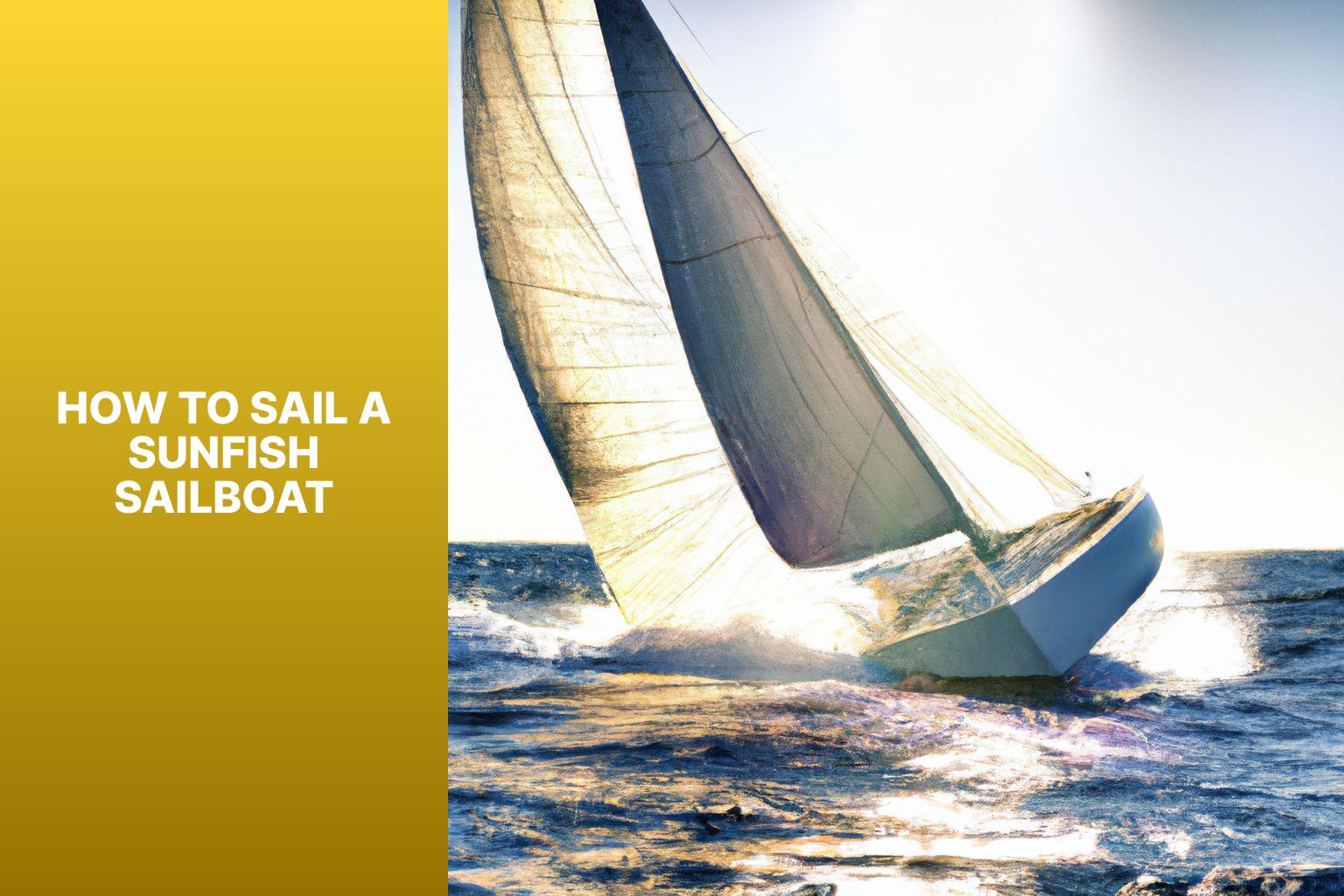
Sailing a Sunfish sailboat can be an exciting and enjoyable experience for both beginners and experienced sailors. Known for their simplicity and versatility, Sunfish sailboats are popular for recreational sailing and racing. If you’re looking to learn how to sail a Sunfish sailboat, this guide will provide you with the basic knowledge and steps to get started.
We’ll begin by introducing you to the Sunfish sailboat and why it’s a great choice for sailing. Then, we’ll cover the basic parts and terminology of a Sunfish sailboat, followed by the necessary preparations before hitting the water. We’ll delve into the step-by-step process of sailing a Sunfish sailboat, including rigging, boarding, wind awareness, sailing maneuvers, and sail control. We’ll provide safety tips to ensure a safe and enjoyable sailing experience, along with common mistakes to avoid.
By the end of this guide, you’ll be equipped with the fundamental knowledge and skills to confidently sail a Sunfish sailboat.
Key takeaway:
- Learning to sail a Sunfish sailboat allows for an exciting and rewarding experience on the water.
- By understanding the basic parts and terminology of a Sunfish sailboat, beginners can become familiar with the equipment needed for sailing.
- Preparing for sailing by checking weather conditions and ensuring the equipment is in proper condition is essential for a safe and enjoyable sailing experience.
What is a Sunfish Sailboat?
A Sunfish sailboat is a small, single-handed sailing dinghy popular for recreational and competitive sailing.
What is a Sunfish Sailboat ? It is designed to be simple and easy to maneuver, making it ideal for beginners and experienced sailors.
The Sunfish sailboat has a unibody construction with a cockpit for the sailor and a single triangular sail.
It is lightweight and has a shallow draft, allowing it to sail in various conditions, including calm lakes and open waters.
The Sunfish is known for its stability and responsiveness, enabling sailors to navigate through waves and make quick turns.
It is easy to rig, launch, transport, and store due to its simplicity and compact size.
Fact: Introduced in 1952, the Sunfish sailboat has become one of the world’s most popular sailboat designs. Over 300,000 boats have been sold worldwide.
Why Learn to Sail a Sunfish Sailboat?
- Fun: Learning to sail a Sunfish sailboat can provide a thrilling and exhilarating experience on the water. Glide through waves, harness the power of the wind, and experience joy and freedom.
- Physical activity: Sailing a Sunfish sailboat requires using your muscles to steer, control the sail, and adjust the rigging. It can improve your overall fitness.
- Developing sailing skills: Sailing a Sunfish sailboat helps cultivate sailing skills like understanding wind patterns, mastering maneuvers, and improving boat handling abilities. These skills are valuable for recreational and competitive sailing.
- Connecting with nature: Being on the water and amidst nature brings peace and tranquility. Sailing a Sunfish sailboat allows you to observe wildlife, enjoy breathtaking views, and connect with the elements.
- Building confidence: Learning to sail a Sunfish sailboat boosts confidence and self-esteem as you develop new skills and overcome challenges.
- Bonding with others: Sailing is a social activity, offering quality time with family, friends, and fellow sailing enthusiasts. Collaborate as a team to operate the sailboat and create lasting memories.
Basic Parts and Terminology of a Sunfish Sailboat
Get ready to set sail as we dive into the world of Sunfish sailboats! In this section, we’ll uncover the essential parts and terminology that every sailor should know. From understanding the hull to exploring the mast and boom, and getting familiar with the rigging, we’ll equip you with the knowledge you need to navigate the waters with confidence. So, grab your life jacket and let’s explore the fascinating components that make up a Sunfish sailboat.
Understanding the Hull
When learning to sail a Sunfish Sailboat , it’s crucial to have a deep understanding of the hull . The hull, made from lightweight and durable fiberglass , allows the sailboat to effortlessly glide through the water. Its “ V ” shape ensures a smooth glide, reducing drag and enabling the sailboat to reach maximum speed. The hull is divided into sections, including the bow and stern , which aid in steering and maneuverability.
Sailors will find comfort in the hull’s spacious cockpit , where they can sit or stand while sailing. This cockpit provides easy access to the sail and rigging , facilitating smooth sailing. The hull may boast additional features such as storage compartments for equipment and a drain plug to remove any excess water.
Understanding the intricate workings of the hull is crucial for safely navigating a Sunfish Sailboat. It empowers sailors to have full control over the sailboat’s direction, make necessary adjustments, and confidently tackle various weather conditions. Therefore, becoming familiar with the hull is not just important but an essential step towards becoming a proficient sailor.
Exploring the Mast and Boom
The mast and boom are crucial components of a Sunfish sailboat that play a vital role in controlling the sail and maneuvering the boat. Let’s delve into their features and functions:
– Mast : The mast is a tall pole crafted from lightweight materials such as aluminum or fiberglass. It offers vertical support to the sail and holds it in place. The mast is inserted into a mast step on the boat’s deck. It can be raised or lowered by utilizing a halyard, which is a line connected to the sail. Sail control lines like the main sheet and boom vang are attached to the mast to ensure efficient control.
– Boom : The boom is a horizontal spar that extends from the mast towards the rear of the sailboat. It aids in controlling the position of the sail by enabling it to move back and forth based on the wind direction. The boom is attached to the mast at the gooseneck, allowing it to pivot upwards and downwards. Its position is regulated by adjusting the outhaul, which is a line responsible for controlling its extension or retraction. The boom serves as a rigid lever that distributes the force of the wind evenly across the sail.
Understanding the mast and boom is essential to effectively control the sail and navigate the Sunfish sailboat. By mastering their functions, sailors can optimize the performance of the boat by adjusting the sail’s position and shape according to the prevailing wind conditions.
Getting Familiar with the Rigging
When familiarizing with the rigging of a Sunfish sailboat, it’s important to understand the parts and their functions. Here’s a helpful list:
By familiarizing with these rigging components, you’ll be prepared to operate a Sunfish sailboat and enjoy sailing.
Fun Fact: The Sunfish sailboat was designed in 1952 by Alexander Bryan and has since become one of the most popular recreational sailboats worldwide. Its simplicity, durability, and versatility make it a favorite among sailors of all skill levels.
Preparing for Sailing
Preparing to set sail on a Sunfish sailboat involves two crucial aspects: checking the weather conditions and ensuring all equipment is ready. Weather conditions play a pivotal role in determining the success and safety of your sailing adventure. Having your equipment meticulously prepared and in optimal condition is essential for a smooth and enjoyable experience . Let’s dive into these sub-sections and uncover the tips and tricks that will help you navigate these preparations like a seasoned sailor .
Checking the Weather Conditions
When preparing to sail a Sunfish sailboat, it is important to check the weather conditions beforehand. This ensures the safety and smooth sailing of your experience. Here are a few factors to consider:
Wind speed: Determine the current wind speed, as it directly impacts your sailing experience. Check the forecast or use a windometer for an accurate reading. Ideally, a moderate wind speed of 5-15 knots is best for sailing a Sunfish sailboat.
Wind direction: Understand the wind’s direction, as it determines your course and maneuverability on the water. Plan your sailing route accordingly, considering obstacles or hazards.
Temperature and weather conditions: Note the temperature and general weather conditions. Extreme weather like thunderstorms or high winds can be dangerous for sailing. Ensure the weather is suitable and safe.
Tides and currents: If sailing in an area with tides or currents, check tide tables or current charts to understand water movements. This helps you plan your sail and avoid unpredictable or hazardous conditions.
By checking the weather conditions before setting sail, you ensure a safer and more enjoyable experience on your Sunfish sailboat. Always prioritize safety and adjust plans based on weather conditions.
Preparing the Equipment
When preparing to sail a Sunfish sailboat , follow these steps to ensure your equipment is ready:
1. Check the condition of the sail, mast, boom, and rigging for damages or issues.
2. Have necessary safety equipment on board, such as life jackets, a whistle, and a first aid kit .
3. Inspect the rudder and tiller to ensure proper functioning and secure attachment.
4. Check the hull for cracks or leaks, and make necessary repairs before setting sail.
5. Ensure the daggerboard is in good condition and properly attached to the boat.
6. Check all ropes, lines, and cleats for good condition and proper connection.
By following these steps, you can ensure that your equipment is in working order and ready for a safe sailing experience on a Sunfish sailboat.
The Sunfish sailboat was designed in 1952 by Alcort, Inc. It gained popularity for its simplicity and ease of use. Originally intended for recreational sailing, it has become a popular choice for racing as well. The design has remained largely unchanged over the years, with minor modifications for improved performance and durability. Today, the Sunfish sailboat is beloved by sailors of all skill levels for its versatility and timeless design.
Steps to Sail a Sunfish Sailboat
Get ready to embark on an exciting and adventurous journey as we uncover the step-by-step process of sailing a Sunfish sailboat . From rigging the sailboat to mastering wind awareness and steering, we’ll cover it all. We’ll also explore the art of sailing maneuvers and controlling the sail, ensuring you have the skills to navigate the open waters with ease. So, grab your sailing gear and let’s dive into the world of Sunfish sailboat sailing!
1. Rigging the Sailboat
To rig a Sunfish sailboat, proper steps must be followed . First, attach the mast to the mast step using a mast step plug. Then, use the boom vang to attach the boom to the mast. Next, slide the luff of the mainsail into the mast groove and secure the tack to the boom. Hoist the mainsail by pulling up on the halyard line and adjust the tension for the sail shape. Control the sail angle by attaching the sheet to the eye strap at the back of the boom. Make sure to adjust the outhaul to control the tension of the bottom of the sail. Check the tension of the halyard, vang, and downhaul ropes for proper sail shape and control. Before sailing, it is crucial to ensure all lines and fittings are secure and properly fastened. Rigging the sailboat correctly is essential for optimal performance and control on the water.
2. Boarding the Sailboat
To board a Sunfish sailboat, follow these steps:
1. Boarding the Sailboat : Approach the sailboat from the side or stern, ensuring stability.
2. Boarding the Sailboat : Step onto the centerboard or daggerboard, placing one foot at a time while balancing your weight.
3. Boarding the Sailboat : Carefully lower yourself onto the deck, keeping a firm grip on the gunwale for support.
4. Boarding the Sailboat : Once on the deck, find your balance and position yourself towards the front of the cockpit, facing the bow of the boat.
5. Boarding the Sailboat : Hold onto the hiking straps or grab rail for stability as you prepare to set sail.
Boarding a sailboat can be challenging, especially for beginners. Approach the boat with caution and use proper technique for a safe and stable entry. By following these steps, you’ll be ready to embark on your sailing adventure on a Sunfish sailboat. Always wear a life jacket and be mindful of your surroundings for safe sailing.
3. Getting into Position
To successfully get into position for sailing a Sunfish sailboat , follow these steps:
- Stand at the boat’s side, facing the bow.
- Grab the edge of the cockpit with one hand for stability.
- Step your other foot into the cockpit, maintaining balance.
- Slowly lower yourself into the cockpit, keeping your weight centered.
- Sit comfortably with a straight back and feet stretched out in front.
- Hold the mainsheet and tiller to control the sailboat.
Pro-tip: Before getting into position, ensure the sailboat is stable and properly balanced to prevent accidents or tipping over while sailing. Adjust your position as needed when the wind and waves change for stability and control of the Sunfish sailboat .
4. Wind Awareness and Steering
To effectively navigate a Sunfish Sailboat and develop wind awareness and steering proficiency, follow these steps:
1. Position yourself: Stand or sit on the boat’s centerline, maintaining balance.
2. Observe wind direction: Look at flags, waves, and ripples on the water to determine wind direction. Pay attention to nearby boats.
3. Feel the wind on your face: Allow the wind to guide your understanding of its strength and direction.
4. Point into the wind: Steer your boat toward the wind to sail upwind or “close-hauled.” Adjust the sail to catch the wind.
5. Release the sail: When sailing downwind, ease the sail to allow the wind to fill it from behind.
6. Adjust sails for optimal power: Make small adjustments to the sail position while sailing on different points of sail, such as reaching and running, to maximize speed and control.
7. Use body weight: Shift your body weight to maintain balance and stability as you adjust the sail and steer the boat through changing wind conditions.
8. Practice steering: Use the tiller to turn the boat in the desired direction. Push the tiller away from you to turn away from the wind, and pull it towards you to turn towards the wind.
9. Avoid excessive steering: Minimize abrupt or excessive steering movements, as they can slow down the boat and make it less stable.
By incorporating wind awareness and mastering steering techniques, you will enhance your ability to navigate a Sunfish Sailboat with proficiency and control.
5. Sailing Maneuvers
- 5.1 Tacking: Tacking, one of the sailing maneuvers, is a technique that changes the sailboat’s direction by turning the bow through the wind. By pushing the tiller away from you and pulling the sail towards the center of the boat, you can execute this maneuver and sail against the wind.
- 5.2 Jibing: Jibing, another sailing maneuver, is a technique that changes the sailboat’s direction by turning the stern through the wind. To perform this maneuver, pull the tiller towards you and adjust the sail to the opposite side of the boat, allowing the sailboat to change course and sail with the wind.
- 5.3 Tacking or Jibing around a buoy: When participating in a race or navigating around a buoy, tacking or jibing around the buoy is a crucial skill to master. This maneuver, requiring precise timing and coordination between the skipper, crew, and wind conditions, allows you to change the sailboat’s direction while rounding the buoy.
- 5.4 Gybing: Gybing, one of the sailing maneuvers, is a technique used to change the sailboat’s direction when sailing downwind. By swinging the stern through the wind, you can execute this maneuver. It is crucial to exercise careful control of the sail and tiller to avoid any accidents.
- 5.5 Heaving to: Heaving to is a sailing maneuver that allows you to stop or slow down a sailboat while maintaining some control over the sail. By positioning the sail and rudder, you can remain stationary or drift in a controlled manner, making this technique an essential skill to learn.
These sailing maneuvers, referred to as 5. Sailing Maneuvers, are of utmost importance in mastering the art of sailing a Sunfish sailboat. To become a skilled sailor and experience the freedom and excitement of sailing, it is recommended to practice these maneuvers in various wind conditions.
6. Controlling the Sail and Adjusting the Rigging
To master the art of controlling the sail and adjusting the rigging of a Sunfish sailboat, follow these steps:
1. Familiarize yourself with the lines and controls on the boat.
2. Properly adjust the boom vang to control sail tension. Excess tension reduces speed, while insufficient tension causes the sail to luff.
3. Check and adjust the mainsheet to control the sail’s position. Tightening the mainsheet increases speed, while loosening it depowers the sail.
4. Adjust the cunningham to control tension at the front of the sail. Tightening it flattens the sail for better efficiency in stronger winds.
5. Monitor the traveler to control the horizontal position of the boom. Adjusting the traveler helps control the sail’s angle and optimize its shape for different wind conditions.
6. Pay attention to the downhaul to control tension in the lower part of the sail. Adjusting the downhaul helps control the sail’s depth and performance.
7. Practice and experiment with different settings to find the optimal sail and rigging adjustments for various wind conditions and sailing maneuvers.
By mastering the art of controlling the sail and adjusting the rigging, you can maximize the performance of your Sunfish sailboat and have a more enjoyable sailing experience.
Safety Tips for Sailing a Sunfish Sailboat
When sailing a Sunfish sailboat, it is important to prioritize safety. Follow these safety tips to ensure a smooth and secure sailing experience:
- Always wear a life jacket while on the water to enhance your safety.
- Prior to setting sail, check the weather forecast to avoid encountering hazardous storms or strong winds.
- To ensure optimal performance, inspect the boat and its equipment before every sail to confirm their proper functionality and condition.
- Stay vigilant and fully aware of your surroundings while sailing. Constantly watch for other boats, obstacles, and any changes in the conditions.
- If you are a beginner, consider taking sailing lessons to acquire the essential techniques and skills for handling the Sunfish sailboat correctly.
- Be mindful of the possibility of capsizing and practice how to right the boat and get back in safely.
- In order to prevent potential accidents, maintain a safe distance from swimming areas and other water activities.
- For emergencies or the need to seek help, bring a communication device, like a waterproof phone case or a marine radio .
- Prior to sailing, inform someone on land about your plans, including your estimated return time and location , as an additional safety precaution.
- Always prioritize safety, trust your instincts, and use common sense while sailing.
Common Mistakes to Avoid
When sailing a Sunfish sailboat, it is important not to make the common mistake of failing to secure the daggerboard. This can result in instability and difficulties in controlling the boat.
Another common mistake to avoid is forgetting to check the wind direction before setting sail. Having knowledge of the wind direction is crucial in adjusting the sails and navigating effectively.
Incorrectly trimming the sails can lead to poor performance and a loss of speed. It is essential to trim the sails properly according to the wind conditions in order to maximize speed and control.
Overloading the boat with excessive weight can negatively impact its stability and maneuverability. It is important to adhere to the recommended weight limits and distribute the weight evenly to maintain balance.
It is a serious mistake to ignore safety precautions such as not wearing a life jacket or disregarding other safety measures. Safety should always be a top priority while sailing, and all necessary safety measures should be followed.
Some Facts About How To Sail A Sunfish Sailboat:
- ✅ The Sunfish is a small, one-person single sail boat that is popular for sailing at summer camps and introducing people to the joy of sailing.
- ✅ The Sunfish features a flat, boardlike hull and a crab claw sail mounted to an un-stayed mast.
- ✅ It is easy to learn to sail a Sunfish, with many people being able to do so in a day through trial and error.
- ✅ Lessons are recommended for those who want to learn to sail a Sunfish.
- ✅ The Sunfish has become extremely popular, with a quarter million sold worldwide as of 1995.
Frequently Asked Questions
How do i install the sunfish sailing web app on my home screen.
To install the Sunfish Sailing web app on your home screen, you need to use the built-in Safari browser. Simply follow these steps:
1. Open Safari on your device. 2. Navigate to the Sunfish Sailing website. 3. Tap the Share button at the bottom of the Safari screen. 4. Scroll down and tap “Add to Home Screen”. 5. Customize the name of the app if desired, then tap “Add”. 6. The Sunfish Sailing web app will now be installed on your home screen.
What is a sail plan and how does it affect a sailboat?
A sail plan refers to the arrangement and size of a sailboat’s sails. It plays a crucial role in determining the boat’s performance, speed, and control. The sail plan, along with the hull design, creates lift forces that propel the sailboat through the water. By adjusting the sail plan, such as the position and angle of the sails, sailors can optimize the balance of forces and improve the boat’s performance.
Are there any YouTube videos available for learning to sail a Sunfish?
Yes, there are YouTube videos available for learning to sail a Sunfish. While videos can provide some guidance, it is recommended to take a class or lessons to learn the basics of sailing a Sunfish. Hands-on instruction and guidance from experienced instructors can greatly help in developing proper sailing techniques and ensuring a safer and more enjoyable sailing experience.
What is a stopper knot and why is it important in Sunfish sailing?
A stopper knot is a knot tied at the end of a rope or halyard to prevent it from pulling out while on the water. In Sunfish sailing, a stopper knot is recommended to secure the halyard, which raises and lowers the sail, to prevent it from accidentally coming undone. It helps ensure proper control over the sail and prevents any mishaps or accidents while sailing.
Do recreation departments offer sailing classes during the summer?
Yes, many recreation departments offer sailing classes specifically during the summer season. These classes are designed to introduce individuals to the fundamentals of sailing and provide them with the necessary skills and knowledge to sail small boats like the Sunfish. Participating in these classes can be a great way to learn and develop a passion for sailing in a structured and supervised environment.
Can a Sunfish sailboat be launched from anywhere with water access?
Yes, a Sunfish sailboat can be launched from various locations with water access. Whether it is from the beach, a dock, or any other suitable waterfront area, the lightweight and easily maneuverable nature of the Sunfish make it convenient for launching and sailing in different water environments. It is important to always consider safety precautions and adhere to local rules and regulations when launching and sailing the boat.
About the author
Leave a Reply Cancel reply
Your email address will not be published. Required fields are marked *
Save my name, email, and website in this browser for the next time I comment.
Latest posts

The history of sailing – from ancient times to modern adventures
History of Sailing Sailing is a time-honored tradition that has evolved over millennia, from its humble beginnings as a means of transportation to a beloved modern-day recreational activity. The history of sailing is a fascinating journey that spans cultures and centuries, rich in innovation and adventure. In this article, we’ll explore the remarkable evolution of…

Sailing Solo: Adventures and Challenges of Single-Handed Sailing
Solo Sailing Sailing has always been a pursuit of freedom, adventure, and self-discovery. While sailing with a crew is a fantastic experience, there’s a unique allure to sailing solo – just you, the wind, and the open sea. Single-handed sailing, as it’s often called, is a journey of self-reliance, resilience, and the ultimate test of…

Sustainable Sailing: Eco-Friendly Practices on the boat
Eco Friendly Sailing Sailing is an exhilarating and timeless way to explore the beauty of the open water, but it’s important to remember that our oceans and environment need our protection. Sustainable sailing, which involves eco-friendly practices and mindful decision-making, allows sailors to enjoy their adventures while minimizing their impact on the environment. In this…
How to Rig a Sunfish: Step-by-Step Guide to Sail Away
Imagine the gentle ripple of water, the whisper of a breeze, and the thrill of harnessing the wind to propel yourself across the water. For sailors, there’s no feeling quite like it, and the Sunfish sailboat offers the perfect vessel for such adventures.
In this comprehensive guide, we embark on a journey to help you master the art of rigging a Sunfish sailboat. Whether you’re a novice eager to set sail for the first time or a seasoned sailor in need of a refresher, this article has you covered.
The Sunfish sailboat is renowned for its simplicity, making it an ideal choice for sailors of all skill levels. Our guide will walk you through the essential steps, from setting up the mast and sail to ensuring your boat is shipshape. So, whether you’re preparing for a leisurely day on the water or gearing up for some friendly racing, read on to discover the secrets of rigging a Sunfish and unlocking the full potential of this iconic sailboat.
Introduction to the Sunfish Sailboat
Nestled at the intersection of simplicity and pure sailing joy, the Sunfish sailboat has been captivating the hearts of sailors for generations. With a history dating back to the mid-20th century, this beloved boat is renowned for its straightforward design and the exhilarating experiences it offers on the water.
For anyone looking to venture into the world of sailing, mastering the art of rigging a Sunfish is an essential skill. It’s the very foundation upon which your sailing adventures will be built. Whether you’re a novice seeking your maiden voyage or a seasoned sailor revisiting the basics, understanding how to properly rig a Sunfish is paramount for safety and a delightful time out on the water.
In this guide, we’ll embark on a journey to demystify the rigging process, step by step. By the end, you’ll not only have the knowledge but also the confidence to set sail on your Sunfish, ready to embrace the wind, waves, and the endless possibilities of the open water. So, let’s dive in and uncover the secrets of rigging the Sunfish sailboat for an unforgettable sailing experience.
Gather Your Tools and Equipment
Before you embark on the process of rigging your Sunfish, it’s crucial to ensure you have all the necessary tools and equipment at your disposal. Here’s a comprehensive list of items you’ll need:
- Sunfish Sail: The sail is the heart and soul of your boat. Ensure it’s in good condition, free of tears or significant wear.
- Mast: The mast is the vertical pole that supports the sail. It should be straight and secure.
- Boom: The boom is the horizontal spar that extends the foot of the sail. Check for any signs of damage or rust.
- Lines (Ropes): You’ll need various lines for controlling the sail, including the halyard (raises the sail), mainsheet (controls the angle of the sail), and other lines for rigging adjustments.
- Daggerboard: This board helps with stability and direction. Ensure it’s securely in place and free of damage.
- Rudder and Tiller: The rudder controls your boat’s direction, while the tiller is the handle you use to steer. Make sure they’re both functioning correctly.
- Life Jacket: Safety first! Always wear a properly fitted life jacket when sailing.
- Paddle: In case the wind dies down or you need to maneuver in tight spaces, a paddle can be a lifesaver.
- Bailer or Sponge: To keep the cockpit dry and free of water, especially if it splashes in.
- Tool Kit: A basic toolkit with pliers, a screwdriver, and a wrench can be handy for minor adjustments.
- Sunscreen and Sunglasses: Protect yourself from the sun’s rays.
- Hat and Water: Stay hydrated and shielded from the sun.
- Whistle or Horn: These are essential safety devices for alerting others in case of an emergency.
Before rigging your Sunfish, inspect all equipment for any wear, damage, or missing parts. Safety should always be a top priority, so ensure your life jacket is in excellent condition and fits snugly. Once everything is in order, you’re ready to begin rigging your Sunfish and setting sail for a fantastic day on the water.
Position the Sunfish on Land or in Shallow Water for Rigging
Before you start rigging your Sunfish, you’ll need to prepare the boat properly. Here’s how to do it:
- Choose the Right Location: Select a location on land or in shallow water that’s free from obstacles and provides ample space to work around the boat.
- Position the Sunfish: Carefully position the Sunfish with the bow (front) pointing into the wind. This is important for a smooth rigging process.
- Level the Boat: Ensure the boat is level from side to side. An uneven boat can make rigging and sailing more challenging.
- Secure the Boat: If you’re on land, make sure the boat is securely supported with appropriate boat stands or supports to prevent it from tipping or moving during rigging.
- Check the Wind: Assess the wind conditions. While it’s okay to rig in a light breeze, strong winds can make the process more difficult. If it’s too windy, consider postponing your rigging or seek help from someone experienced in handling a Sunfish in windy conditions.
- Gather Your Gear: Double-check that you have all the necessary tools and equipment nearby, as mentioned earlier.
By positioning the Sunfish correctly, ensuring it’s level, and taking wind conditions into account, you’ll set the stage for a smooth rigging process and a safe and enjoyable sailing experience.
Process of Stepping the Mast, Which Involves Attaching the Mast to the Boat’s Hull
Stepping the mast is a crucial step in rigging your Sunfish. Follow these steps carefully:
- Attach the Mast Step: The mast step is a metal fitting on the boat’s deck near the bow. Insert the bottom end of the mast into the mast step. Ensure it fits snugly and securely.
- Align the Mast: With the mast in the mast step, position it vertically. Check for any lateral (side-to-side) or forward-leaning tilt. The mast should be perfectly upright.
- Attach the Forestay: The forestay is the front rigging line that goes from the top of the mast to the front of the boat. Hook the forestay to the bow eyelet or fitting. Make sure it’s securely attached.
- Secure the Shrouds: The shrouds are the side rigging lines that keep the mast in position. Attach one end of each shroud to the eyelets on the sides of the boat, near the gunwales. The other end of each shroud should be attached to the chainplates on the sides of the mast.
- Adjust Tension: Properly tension the forestay and shrouds. The rigging lines should be tight enough to support the mast but not overly tight, as this can distort the hull. The mast should remain vertical and secure.
- Inspect All Attachments: Double-check that all attachments are secure, and there’s no slack in the rigging lines. Ensure the mast is firmly in the mast step.
Properly stepping the mast and ensuring correct alignment, tension, and secure attachments are essential for safe and efficient sailing. A well-rigged Sunfish will perform better and provide a more enjoyable experience on the water.
Attach the Boom to the Mast and the Sail to the Boom
Attaching the boom and sail correctly is vital for effective sailing. Here’s how to do it:
- Attach the Boom to the Mast: The boom is the horizontal spar that extends perpendicular to the mast. Slide the gooseneck fitting on the front of the boom onto the mast. The gooseneck should fit snugly on the mast, and the boom should rest horizontally.
- Secure the Mainsheet: The mainsheet is the line that controls the angle of the sail. Attach one end of the mainsheet to the eyelet on the back of the boom. The other end will be handled by the sailor while sailing.
- Attach the Sail to the Boom: Slide the sail’s foot (bottom edge) into the boom’s groove, starting from one end and working your way to the other. Make sure the sail is centered on the boom. Secure the sail by tightening the boom vang, a line running from the back of the boom to the mast.
- Tension the Sail: Pull the halyard line (located on the front side of the mast) to raise the sail. The sail should be taut but not overly tight. Adjust the downhaul line (attached to the tack of the sail) to control the tension in the lower part of the sail.
- Adjust the Outhaul: The outhaul line (attached to the clew of the sail) controls the tension in the sail’s foot. Adjust it to achieve the desired sail shape.
- Check Sail Shape: Stand behind the boat and look at the sail’s shape. It should be smooth and evenly tensioned, with no excessive wrinkles or creases. Make adjustments as needed.
- Secure Loose Ends: Secure any loose lines and ensure nothing is dangling or obstructing the sail’s movement.
Properly attaching the boom and sail, as well as adjusting the halyard, downhaul, and outhaul lines, is essential for sail control and efficient sailing. Ensure that all lines are free from tangles or snags, as this will help maintain control over the sail during your voyage.
Daggerboard and Rudder Installation
Inserting the daggerboard:.
- Locate the daggerboard slot on the centerline of the Sunfish hull, typically near the cockpit.
- Hold the daggerboard vertically with the tapered end facing downward.
- Insert the daggerboard into the slot, starting from the top. Ensure it slides smoothly into place.
- Continue pushing the daggerboard down until it rests securely in the slot and is fully submerged in the water. The daggerboard provides stability and prevents lateral movement when sailing.
Attaching the Rudder:
- The rudder consists of the rudder blade and the rudder head. The rudder head fits into a bracket on the back of the boat.
- Insert the rudder head into the bracket and push it down until it clicks or locks into place. There is often a pin or mechanism that secures the rudder in the bracket.
- Ensure the rudder blade is perpendicular to the boat’s centerline and extends downward into the water. The rudder controls your boat’s direction and is crucial for steering.
Checking Control Lines:
Examine the control lines associated with the rudder:
- Tiller: The tiller is the wooden or metal bar connected to the rudder head. Make sure it is securely attached to the rudder head and that it moves freely to steer the boat.
- Tiller Extension: If your Sunfish has a tiller extension, check that it is attached and functioning correctly. The extension allows you to control the rudder while seated.
- Rudder Downhaul Line: The rudder downhaul line controls the angle of the rudder blade. Ensure it is properly adjusted to your desired steering responsiveness.
Properly installing the daggerboard and rudder and ensuring the associated control lines are in good working order are essential steps before setting sail. These components play a critical role in maintaining control and stability while on the water.
Rigging the Various Lines for Sail Control, Including the Mainsheet, Outhaul, and Vang
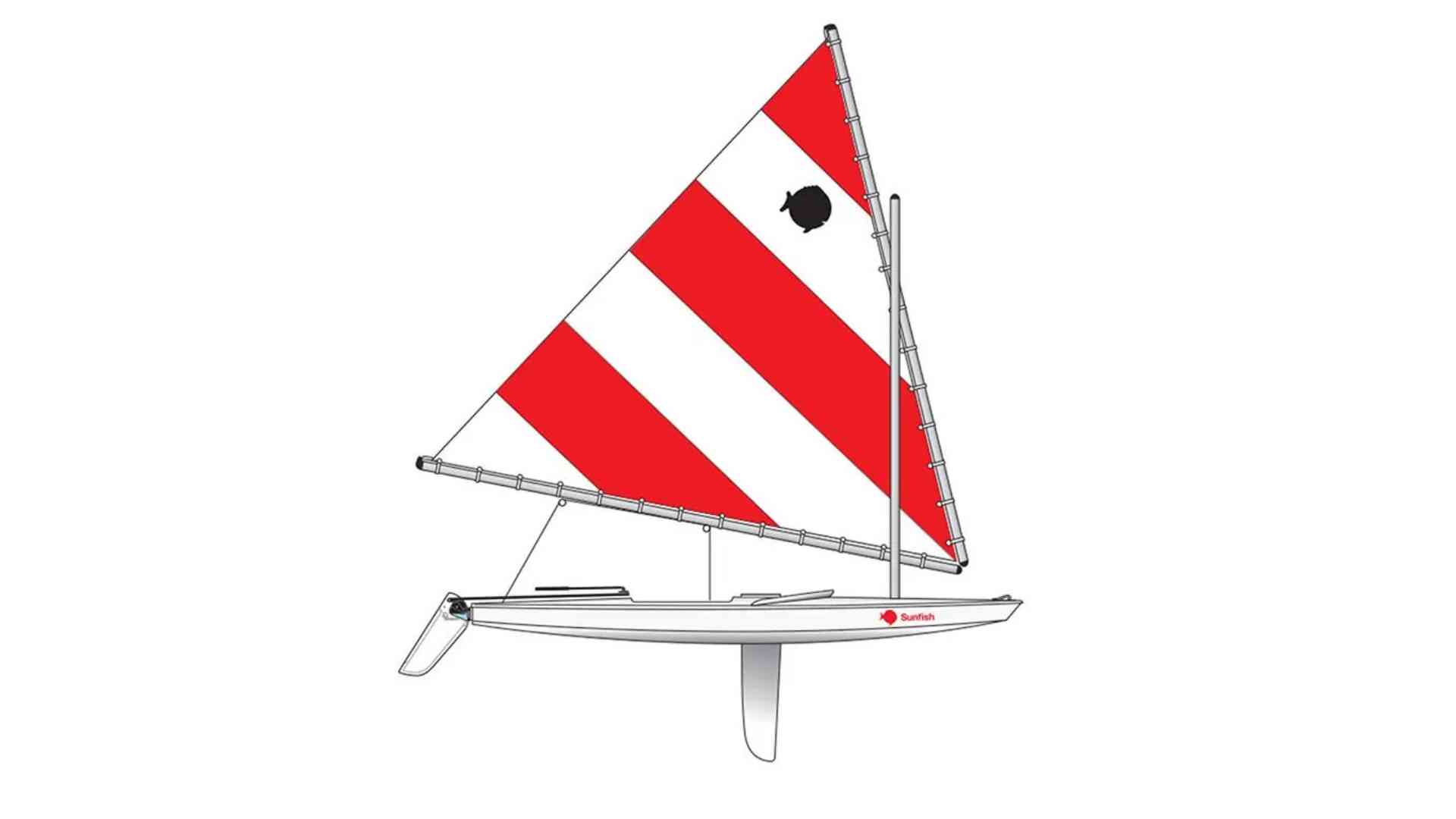
- The mainsheet controls the angle of the sail, affecting your boat’s speed and direction.
- Attach one end of the mainsheet to the aft end of the boom, typically with a bowline knot.
- Thread the other end through the mainsheet block, which is typically attached to the traveler bar on the boat’s cockpit floor.
- Bring the mainsheet line up to the sail’s clew (the lower back corner of the sail) and pass it through the aft grommet (a reinforced hole) in the sail.
- Pull the mainsheet line down, creating tension in the sail. The mainsheet should run freely through the block for easy adjustments while sailing.
- The outhaul adjusts the tension in the foot (bottom) of the sail.
- Attach one end of the outhaul line to the clew of the sail, usually through the outhaul grommet.
- Thread the other end of the outhaul line through the outhaul block or pulley on the boom.
- Adjust the outhaul to your desired sail shape and tension by pulling or releasing the line.
Vang (Optional):
- The vang controls the tension in the leech (back edge) of the sail.
- Attach one end of the vang to the gooseneck fitting on the mast.
- Thread the other end through the vang block on the boom.
- Adjust the vang to control the twist in the sail by pulling or releasing the line.
Cleating Lines:
- Many Sunfish sailboats have cleats to secure lines, allowing for hands-free sailing.
- To cleat a line, simply wrap it around the appropriate cleat and pull it tight. The cleat will hold the line in place.
- To release a cleated line quickly, pull it upward and away from the cleat.
Properly rigging and adjusting these control lines is crucial for sail control and optimizing your boat’s performance. The mainsheet, outhaul, and vang give you control over the sail’s shape, angle, and tension, allowing you to harness the wind effectively while sailing your Sunfish.
Performing Safety Checks Before Setting Sail
Before setting sail on your Sunfish, safety should always be a top priority. Here are some essential safety checks and precautions:
- Buoyancy Check: Ensure that your Sunfish is positively buoyant, meaning it will float even if swamped or capsized. Check for any hull damage or leaks that could affect buoyancy.
- Secure All Lines: Double-check that all lines, including the mainsheet, outhaul, vang, and control lines, are properly secured and free from tangles or knots.
- Equipment Condition: Inspect all equipment, such as the daggerboard, rudder, and sail, to ensure they are in good condition and properly attached., Verify that the mast, boom, and rigging are secure and free from damage or wear.
- Life Jackets: Always wear a Coast Guard-approved life jacket while on the water, and ensure that any passengers also have access to life jackets that fit them properly.
- Safety Guidelines: Familiarize yourself and your passengers with safety guidelines, such as proper body positioning in the boat and what to do in case of capsizing or other emergencies.
- Weather Check: Before heading out, check the weather forecast. Avoid sailing in severe weather conditions, strong winds, or thunderstorms.
- Emergency Gear: Carry essential emergency gear, including a whistle, paddle, bailer, and a means of communication (e.g., a waterproof phone or VHF radio).
- Float Plan: Let someone ashore know your sailing plans, including your intended route and estimated return time. This helps ensure someone is aware of your whereabouts in case of an emergency.
- Boating Knowledge: Ensure you have the necessary knowledge and skills for sailing a Sunfish, especially if you are a beginner. Consider taking a sailing course or sailing with an experienced sailor until you gain confidence.
- Stay Hydrated and Sun-Protected: Bring water to stay hydrated during your sail, especially on hot days., Protect yourself and passengers from the sun with sunscreen, hats, and sunglasses.
By prioritizing safety and performing these pre-sail checks, you can enjoy your Sunfish sailing adventures with peace of mind, knowing that you are well-prepared for a safe and enjoyable experience on the water.
Conclusion and Setting Sail
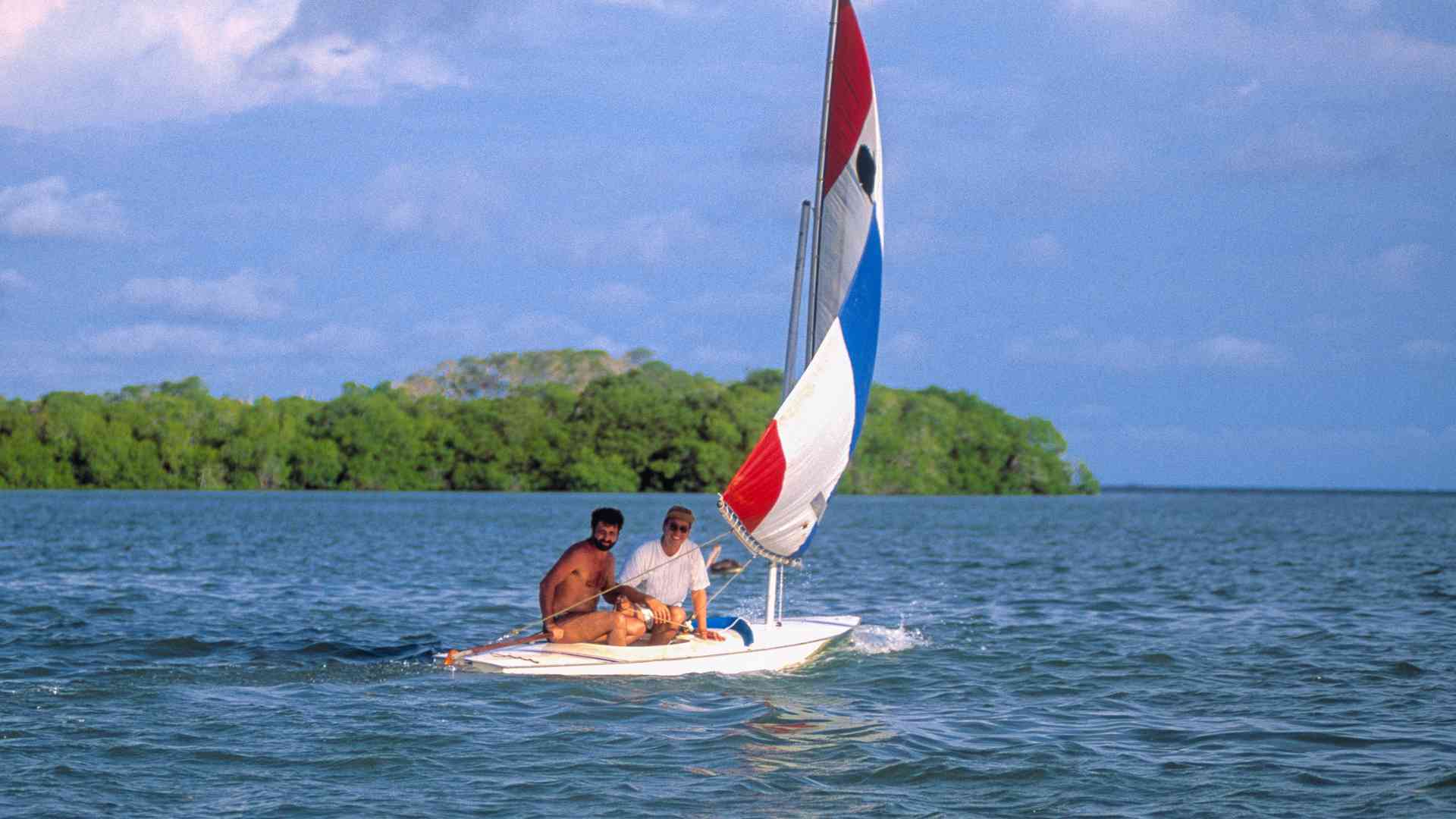
In conclusion, rigging a Sunfish sailboat is a fundamental skill that allows you to embark on exciting sailing adventures. We’ve covered the step-by-step process, from gathering your tools and equipment to performing safety checks before setting sail.
As you gain experience and confidence in rigging your Sunfish, you’ll discover the joy and freedom of sailing. It’s a skill that opens the door to countless adventures on the water, whether you’re exploring new places, racing with fellow sailors, or simply enjoying a peaceful day on the lake.
Remember that practice makes perfect. The more you rig your Sunfish and set sail, the more proficient you’ll become. Over time, rigging will become second nature, and you’ll be able to focus on the pure pleasure of sailing.
So, take these instructions to heart, get out on the water, and enjoy the wind in your sails as you create unforgettable memories aboard your Sunfish sailboat. Sailing offers a lifetime of enjoyment, and rigging your boat is just the beginning of your exciting journey on the water. Happy sailing!
Share How to Rig a Sunfish: Step-by-Step Guide to Sail Away with your friends and Leave a comment below with your thoughts.
Read New Impeller Not Pumping Water: Troubleshoot and Fixing until we meet in the next article.
Similar Posts

Why Is Boat Speedometer Not Working? Reasons + Guide to Fix
Introduction to the topic When it comes to boating, a speedometer plays a vital role in ensuring a safe and enjoyable experience on the water. It provides valuable information about the speed at which the boat is moving through the water, allowing the captain to make informed decisions and navigate effectively. However, encountering a malfunctioning…

Boat Fuel Gauge Reading Full When Empty: Troubleshoot Guide
A malfunctioning boat fuel gauge can quickly turn a relaxing day on the water into a frustrating experience. Picture this: you set out for a day of boating, confident that your fuel tank is full, only to realize later that your boat is running on empty while your fuel gauge stubbornly reads “full.” It’s a…
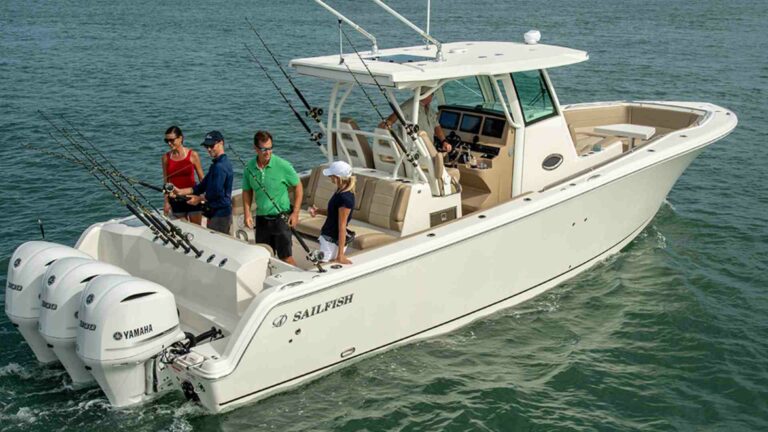
Are Sailfish Boats Good & Reliable Enough to Own?
The allure of the open sea, the gentle sway of waves, and the promise of adventure—owning a boat is a dream for many. For those considering the purchase of a boat, Sailfish Boats often emerge as a compelling option. But the burning question remains: Are Sailfish Boats good and reliable enough to own? In this…
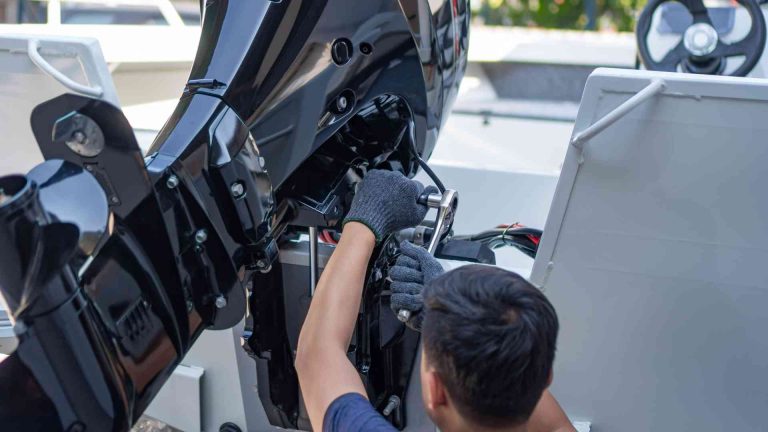
4 Symptoms to Detect a Clogged VST Filter
Picture this: you’re out on the water, the sun is shining, and the gentle waves carry you across the lake. Suddenly, your boat’s engine sputters and loses power, bringing your idyllic day to a halt. If this scenario sounds all too familiar, you know how crucial a smoothly running engine is to your boating experience….
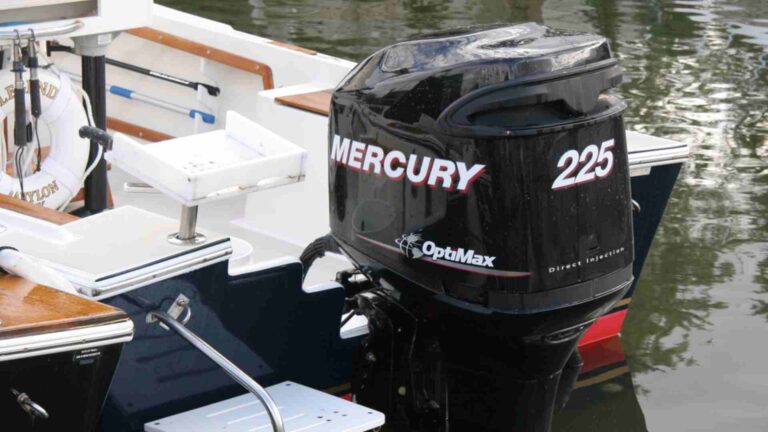
5 Most Common Problems with Mercury Optimax 225
The Mercury Optimax 225, a powerful and popular outboard engine, has garnered a reputation for its performance and reliability. However, like any mechanical device, it’s not immune to occasional problems. Understanding and addressing these common issues can help maintain the engine’s longevity and optimal performance. 1. Power Loss and Rough Idling: One of the most…

How to Troubleshoot Boat Electrical Problems?
A well-functioning electrical system is the heartbeat of any boat, vital for powering essential navigation equipment, communication devices, lighting, and even the comforts of modern amenities. The allure of the open water, however, can quickly dim when faced with electrical glitches that disrupt the seamless operation of a vessel. Imagine a navigation system failing amidst…

How To Sail A Sunfish
Greetings, fellow sailing enthusiasts! If you’re reading this, then you are probably interested in learning how to sail a Sunfish. Whether you’re a complete beginner or have some experience navigating the waters, mastering the skills and techniques needed to sail a Sunfish can be both challenging and rewarding.
Before we dive into the details, it’s important to understand that sailing a Sunfish requires a combination of physical and mental skills. It’s not just about pushing the boat along with the wind; it’s also about reading the water, understanding the weather, and adjusting your body and sails to maintain balance and control. But fear not, with practice and patience, anyone can learn how to sail a Sunfish.
Key Takeaways:
- Sailing a Sunfish requires a combination of physical and mental skills.
- Understanding the basics is essential to mastering Sunfish sailing techniques.
- Practice regularly to improve your skills and enjoy the exhilarating experience of sailing a Sunfish.
Understanding the Sunfish
Before you can set sail on a Sunfish, it’s important to understand the basic components of the boat and how to rig it properly. Here, I will guide you through the essential steps to get your Sunfish ready for sailing.
The Components of a Sunfish
A Sunfish consists of several key components:
Rigging Your Sunfish
Before you can set sail, you’ll need to rig your Sunfish properly. Here are the basic steps:
- Attach the sail to the mast, making sure it is securely fastened.
- Attach the boom to the bottom of the sail.
- Insert the daggerboard into the slot in the center of the boat.
- Attach the rudder to the back of the boat.
- Attach the mainsheet (the line that controls the sail) to the back of the boom.
With your Sunfish properly rigged, you’re now ready to set sail and explore the open waters. But before you do, make sure you understand the wind and weather conditions, as I’ll explain in the next section.
Getting Familiar with Wind and Weather
As I mentioned earlier, understanding wind direction, speed, and weather conditions is crucial when sailing a Sunfish. In this section, I will discuss how to read the wind and adjust your sails for optimal performance.
Firstly, it’s important to know that the wind direction is indicated by a flag or wind vane on the masthead. The vane should always be pointing towards the wind, so if it’s pointing left, turn left, and if it’s pointing right, turn right.
One of the most important sailing techniques is maintaining the correct sail angle in relation to the wind. A sail angled too close to the wind will stall, while a sail angled too far from the wind will luff or flap. The key is to find the “sweet spot” where the sail is filled with wind and pulling the boat forward with maximum efficiency.
How do you adjust the sail angle? By moving the sail’s “sheet,” which is the rope that controls the sail’s position. Pulling the sheet towards you will tighten the sail and angle it towards the wind, while releasing the sheet will loosen the sail and angle it away from the wind.
In addition to wind direction, you also need to be aware of wind speed and weather conditions. Stronger winds require smaller sails, while lighter winds allow for larger sails. You should also be mindful of potential hazards such as storms, high waves, or other boats in the area.
By understanding the basics of wind and weather, you’ll be able to adjust your sails and sail more efficiently, making for a more enjoyable and successful sailing experience.
Boarding the Sunfish
Now that you have rigged your Sunfish and familiarized yourself with the basics , it’s time to board the boat and set sail. Boarding a Sunfish may seem daunting at first, but with a little practice, it can become second nature. Here’s how:
- Step onto the boat from a dock or shallow water, positioning yourself near the center of the boat.
- Slowly shift your weight forward, keeping your balance centered over the boat.
- As the boat starts to move forward, position yourself on the windward (upwind) side of the boat by stepping over the cockpit and onto the other side.
- As you move to the windward side, grab the tiller and main sheet, keeping your weight balanced over the boat.
- Make any necessary adjustments to the sails and steering to get the boat moving in the desired direction.
Remember to take your time and stay calm. With practice, you’ll be able to board a Sunfish with ease, and set sail confidently into the water.
Basic Sailing Maneuvers
Now that you’re comfortable with the basics of sailing a Sunfish, it’s time to learn some fundamental maneuvers. Let’s start with steering. To turn the boat, simply shift your weight to the side you want to turn towards. This will help the sail catch more wind on that side and turn the boat in the desired direction.
If you need to make a sharp turn, you can also use the tiller. Pull the tiller towards you to turn the boat to the left, and push it away from you to turn to the right. Remember to keep your weight balanced and your eyes on the sail to maintain control.
Another important maneuver is called “coming about,” commonly known as tacking. This involves turning the boat into the wind, changing the sail’s position, and then turning the boat in the opposite direction. To perform this maneuver properly, start by turning the boat towards the wind, then quickly cross the sail to the other side, and turn the boat in the new direction.
Jibing, on the other hand, involves turning the boat away from the wind. This maneuver is more advanced and requires careful attention to the sail’s position to avoid capsizing. To jibe, start by turning the boat away from the wind, then shift the sail to the opposite side while keeping the boom directly over the boat.
Practice these basic maneuvers in calm waters before attempting them in more challenging conditions. With practice, you’ll be able to master these fundamental sailing techniques and enjoy the thrill of sailing a Sunfish even more.
Harnessing the Power of the Wind
When sailing a Sunfish, understanding how to effectively use the wind is crucial for achieving maximum speed and control. One key technique is trimming your sails, which involves adjusting the sail’s angle to control the amount of wind it captures. To trim the mainsail, simply pull the sheet (rope that controls the sail) until the sail fills with wind, but doesn’t flutter. Similarly, to trim the jib, adjust the jib sheet until the sail is fully extended and taut.
Another important technique is adjusting the angle of attack, or the angle between the sail and the direction of the wind. When sailing upwind, you want the sails to be at a tighter angle to the wind, while downwind, you want a wider angle. Adjust the sail’s angle of attack by moving the sail forward or aft along the boom.
Finally, it’s important to properly harness the power of the wind for maximum speed and control. When sailing upwind, try to keep the boat as flat as possible by adjusting the daggerboard and hiking out (leaning out over the side of the boat) to counteract the resistance of the water. When sailing downwind, allow the boat to heel (tilt) slightly to one side to catch more wind in the sail and increase speed.
Tacking and Jibing
Now that you have mastered the basics of steering and controlling your Sunfish, it’s time to learn two essential maneuvers for changing direction: tacking and jibing.
Tacking is when you turn the bow of the boat through the wind so that the sails switch sides. This is useful when you need to sail upwind in a zigzag pattern, known as beating. Here’s how to do it:
Jibing is when you turn the stern of the boat through the wind so that the sail switches to the other side. This maneuver is used when you need to change direction while sailing downwind. Here’s how to do it:
Remember to always keep a lookout for other boats and obstacles while tacking or jibing. With practice, you’ll be able to execute these maneuvers smoothly and confidently.
Upwind Sailing Techniques
When sailing upwind on a Sunfish, it’s important to make the most of the wind and sail efficiently against the resistance. Here are some tips to help you master upwind sailing:
- Trim the sails: To sail upwind, you need to point your boat in the direction of the wind. Adjust the sails so that they are perpendicular to the wind and trim them for maximum efficiency. Try not to let the sails luff, as this will slow you down.
- Adjust the daggerboard: Keep the daggerboard angled slightly forward to reduce resistance. As you sail closer to the wind, gradually move the daggerboard towards a vertical position to minimize drift.
- Maintain proper body positioning: To help your boat sail more efficiently, lean your body towards the centerboard. This will shift the weight towards the windward side and reduce drag, allowing the boat to sail faster. Keep your arms and legs relaxed to maintain balance.
Practicing upwind sailing can be challenging, but with patience and consistent effort, you can master this technique and enjoy the thrill of sailing upwind on your Sunfish.
Downwind Sailing Techniques
When sailing a Sunfish downwind, it’s important to be aware of the wind and sail position to maintain control and speed. To achieve optimal sailing conditions, follow these helpful tips:
- Position the sail: While sailing downwind, position the sail perpendicular to the boat, with the boom on one side and the sail on the other. This will allow the wind to fill the sail and propel the boat forward.
- Adjust the sail: Keep the sail slightly eased out to take advantage of the wind and maintain a steady speed. Too much tension on the sail can cause the boat to tip over.
- Trim the sail: If the wind begins to drop, adjust the sail by pulling it in towards the center of the boat, gradually increasing tension until you feel the wind’s power again.
- Control the rudder: To maintain your course while sailing downwind, use the rudder to steer and keep the boat on track. Make small adjustments to avoid turning the boat too quickly and losing speed.
Remember to always keep a watchful eye on other boats and obstacles while sailing downwind. Avoid sudden movements and keep a steady hand on the tiller to maintain control. With the right technique and a bit of practice, sailing a Sunfish downwind can be a thrilling experience!
Safety Precautions
As a responsible Sunfish sailor, I cannot stress enough the importance of safety measures. Here are some essential safety precautions to follow:
- Wear a life jacket: Always wear a properly fitted life jacket when sailing. Ensure it fits snugly and does not restrict your movement.
- Check weather conditions: Before sailing, check the weather forecast and be prepared for any changes in conditions. Avoid sailing in strong winds, thunderstorms, or other extreme weather.
- Be aware of potential hazards: Familiarize yourself with the waters you will be sailing in. Look out for rocks, shoals, and other dangerous obstacles that can damage your boat or cause injury.
- Keep a lookout: Always keep an eye out for other boats, swimmers, and other potential hazards. Be mindful of your surroundings and adjust your course accordingly.
- Carry safety equipment: Carry a whistle, a waterproof flashlight, and a first aid kit in case of emergencies. Store them in a dry, easily accessible place on your boat.
- Stay alert: Sailing can be tiring, especially for beginners. Take breaks as needed and stay hydrated. Avoid using alcohol or other substances that can impair your judgment.
Following these safety precautions can help ensure a safe and enjoyable sailing experience. Remember, safety first!
Troubleshooting and Maintenance
Sailing a Sunfish can be a wonderful experience, but it is important to be prepared for any issues that may arise while on the water. Here are some common problems that beginners may encounter and tips for troubleshooting :
In addition to troubleshooting , it is important to maintain your Sunfish to ensure a safe and enjoyable sailing experience. Here are some basic maintenance practices to follow:
- After every use, rinse the boat and all components with fresh water.
- Store the boat in a cool, dry place out of the sun and wind.
- Check all ropes, lines, and fittings regularly for wear and tear.
- Inspect the hull for cracks or damage, and repair as necessary.
- Keep the daggerboard and rudder in good condition by sanding and varnishing them before and after each sailing season.
By following these troubleshooting and maintenance tips, you can ensure that your Sunfish sailing experience is safe, enjoyable, and free from unexpected problems.
Learning to sail a Sunfish can be a rewarding and exhilarating experience. As I explored in this article, it is essential to master the basics of rigging, wind and weather, boarding, and sailing maneuvers. By practicing regularly and following essential safety precautions, you can enjoy the fun and excitement of sailing in no time.
Remember to keep an eye on the weather conditions and always wear a life jacket. Tacking and jibing may take some practice, but with time, you can master these essential maneuvers smoothly. Additionally, understanding how to harness the power of the wind, sail upwind, and downwind can help you sail efficiently and achieve maximum speed.
If you encounter any issues while sailing, don’t panic. Refer to the troubleshooting tips and basic maintenance practices that we discussed in this article. Finally, seek further instruction and enjoy the exciting experience of sailing a Sunfish!
Q: How do I rig a Sunfish?
A: To rig a Sunfish, start by attaching the mast to the mast step at the bow of the boat. Next, attach the boom to the gooseneck on the mast. Then, raise the sail by pulling up the halyard and secure it with the halyard cleat. Finally, attach the rudder and daggerboard, making sure they are properly secured.
Q: How do I read the wind when sailing a Sunfish?
A: When sailing a Sunfish, it’s important to pay attention to the wind direction and speed. Look for visual cues such as the movement of flags, ripples on the water, and the position of other boats. Adjust your sails accordingly to take advantage of the wind and maximize your performance on the water.
Q: What safety precautions should I take while sailing a Sunfish?
A: Safety should always be a top priority when sailing a Sunfish. Wear a life jacket at all times, especially if you are a beginner or in challenging conditions. Check the weather forecast before heading out and be aware of potential hazards such as rocks, buoys, and other boats. Always sail within your skill level and be prepared for emergencies.
Q: How do I troubleshoot common issues while sailing a Sunfish?
A: If you experience common issues while sailing a Sunfish, such as capsizing or getting stuck in irons, there are solutions. To recover from a capsize, stay calm, hold onto the boat, and follow the proper procedure to right the boat and get back on board. To get out of irons, shift your weight to help the boat turn into the wind or use the tiller to steer the boat into a different direction.
Q: How do I maintain my Sunfish?
A: Proper maintenance is essential to keep your Sunfish in good condition. Rinse the boat with fresh water after each use to remove salt and dirt. Store the boat in a dry and secure location, away from extreme temperatures and direct sunlight. Regularly inspect the sails, rigging, and fittings for any signs of wear or damage and make necessary repairs promptly.
- New Sailboats
- Sailboats 21-30ft
- Sailboats 31-35ft
- Sailboats 36-40ft
- Sailboats Over 40ft
- Sailboats Under 21feet
- used_sailboats
- Apps and Computer Programs
- Communications
- Fishfinders
- Handheld Electronics
- Plotters MFDS Rradar
- Wind, Speed & Depth Instruments
- Anchoring Mooring
- Running Rigging
- Sails Canvas
- Standing Rigging
- Diesel Engines
- Off Grid Energy
- Cleaning Waxing
- DIY Projects
- Repair, Tools & Materials
- Spare Parts
- Tools & Gadgets
- Cabin Comfort
- Ventilation
- Footwear Apparel
- Foul Weather Gear
- Mailport & PS Advisor
- Inside Practical Sailor Blog
- Activate My Web Access
- Reset Password
- Pay My Bill
- Customer Service

- Free Newsletter
- Give a Gift

How to Sell Your Boat

Cal 2-46: A Venerable Lapworth Design Brought Up to Date

Rhumb Lines: Show Highlights from Annapolis


Open Transom Pros and Cons

Leaping Into Lithium

The Importance of Sea State in Weather Planning

Do-it-yourself Electrical System Survey and Inspection

Install a Standalone Sounder Without Drilling

Rethinking MOB Prevention

Top-notch Wind Indicators

The Everlasting Multihull Trampoline

In Search of the Snag-free Clew

What’s Involved in Setting Up a Lithium Battery System?

Reducing Engine Room Noise

Breaking Point: What Can Go Wrong With Your Yanmar?

Mildew-resistant Caulks for Boats

Can We Trust Plastic Boat Parts?

Repairing Molded Plastics

Mailport: Marine plywood, fuel additives, through bolt options, winch handle holders

The Day Sailor’s First-Aid Kit

Choosing and Securing Seat Cushions

Cockpit Drains on Race Boats

Rhumb Lines: Livin’ the Wharf Rat Life

Safer Sailing: Add Leg Loops to Your Harness

Resurrecting Slippery Boat Shoes

Tricks and Tips to Forming Do-it-yourself Rigging Terminals

Marine Toilet Maintenance Tips

Learning to Live with Plastic Boat Bits

The Ultimate Guide to Caring for Clear Plastic
- Sailboat Reviews
Practical Sailor Reviews Seven Performance-Sailing Dinghies
Agile, fun boats like the classic sunfish and new hobie bravo keep the smile in summer sailing..

Photos by Ralph Naranjo
Messing around in small boats is a global theme-one thats embraced by pond-bound pram sailors, river riders, lake voyagers, and all of us who call salt water home. The purpose of this sailing dinghy profile is to highlight seven very interesting little sailboats. Some are new designs, and others have stood the test of time, but all are currently being manufactured, and each drives home just how much fun sailing close to the water can be.
This isn’t a shootout among anorexic speedsters or a report on the best tender that doubles as a sailing dinghy. Its a look at perennials like the Optimist, Sunfish, and Laser-legendary competitors that have helped spawn some of the best sailors in the world. But its also a look at three of the newest entries in the dinghy-sailing circle: Bics Open, Hobies Bravo, and Laser Performances Bug. These agile, new sailing dinghies are chock full of fun and boat-handling features to inspire kids of all ages to go sailing.
Well also take a look at Chesapeake Light Crafts kit approach to getting started-one that offers meaningful lessons and tangible rewards well before the boat ever hits the water.
Scale down an Open 60, add sail technology long favored by windsurfers, and put it into play in a tough thermo-formed hull, and you have the makings for a new kind of watercraft. The result is a very interesting blend of performance and reliability that targets adolescent interest. When all is said and done, Bics boat is more akin to a sit-down windsurfer than a traditional Blue Jay. And like all good boats, its vying for attention not just based on performance, construction quality, and style, but just as importantly, on the price tag stuck to the hull.
The Open Bics light weight and wide, flat stern section means that even small chop can be surfed; and bursts of planing on a reach add a zing factor to dinghy sailing. The Open Bic is already an International Sailing Federation (ISAF)-sanctioned class, and fleets are developing around the US. Another bonus: Its an easily portable boat that can be carried like a windsurfer, adding excitement to a Sunday picnic at the beach.
The thermo-formed polyethylene hull is a modified hard-chine design with lots of beam aft. Sailed flat, the boat is agile enough to surf wavelets, and with a shape thats ergonomically friendly to hiking, the ensuing heel on the upwind leg puts just the right amount of chine into the water. In light air, careful control of heel can significantly reduce wetted surface.
The design team that developed the Open Bic saw it as a transition bridge from Optimist sailing to a more performance-oriented dinghy. An interesting innovation is that the Open Bic can be sailed with an Optimists rig and blades. This buy the hull only approach can be a significant incentive for parents with children outgrowing their Opti as fast as their boat shoes. However it wont be long before the kids want the fully turbo-charged feel delivered with the Open Bics well-shaped 4.5-square-meters rig, sail, and nicely foiled blades.
Bottom line: The Open Bic is fast, agile, and buckets of fun for kids uninspired by sailing in the slow lane.
Just when you think that Hobie Cat Co. has covered whats possible in beach-cat innovation, their design/engineering crew comes up with a new twist that reinvents the wheel. The Hobie Bravo is a good case in point.
In a recent visit to Backyard Boats ( www.backyardboats.com ) in Annapolis, Md., we got a good look at the Bravo. Nearly as narrow as a monohull but still quite stable, this quick-to-launch beach cat packs plenty of get-up-and-go. Its a simple to sail, entry-level boat that fast tracks learning the steer, sheet, and hike trilogy. The boat features a single, midline rudder and roto-molded hulls. The shape of the hulls provides enough lateral plane to allow a crew to make headway to windward.
The narrow (4 feet), 12-foot Bravo uses crew weight and hiking straps to add to the righting moment once the breeze is up. Whats done with webbing on larger cats has been converted to a shallow, rigid deck well on the Bravo. It does raise the weight of the boat to 195 pounds, but it offers comfortable seating plus room for cushions and a cooler. Kids or grown ups can have a Tom Sawyer-Huck Finn type of adventure aboard this fun little sailing machine. Or the family on a beach picnic can set it up and take turns speed reaching along a sandy shoreline.
The furling mast supports a roachy sail with slightly slanted vertical battens, helping to shape the boomless mainsail. The result is convenient sail handling, decent performance, and superior safety. Theres no boom to clobber the crew, and the roller-furled sail and mast are easily stepped in the tripod-like receiver. This interesting set of struts raises the top bearing point of the mast step and spreads rig loads out to the hulls. The furling mainsail offers the ability to reef, a big plus in a building breeze or when teaching children to sail.
Like all of the boats in the Hobie lineup, theres a wide range of specialty parts and fittings that make the boats fast to rig and easy to handle. The kick-up rudder is hung on gudgeons mounted in the center of stern, and just as rig loads have been effectively spread via the tripod step, the energy radiating from the large rudder is spread athwartships via a contoured deck element.
Bottom line: The boat is quick to rig, easy to launch, and responsive to beginners-more experienced sailors will have just as much fun power reaching when the breeze is up.

A pocket-sized club trainer, the Bug is an evolution of the kids trainer/club racer that leverages lessons learned in Optis, Dyers, and Sabots. It pulls together the logic of a stable hull shape and simple-to-sail rig, and puts it all in a cost-effective package.
Lending to its success is designer Jo Richardss ergonomic, roto-molded hull, a fabrication that is as close to zero maintenance as a boat can get. The straight out-of-the-mold polyethylene skin gets a few decals, and theres no wood to refinish or gelcoat to wax. These tough, abrasion-resistant hulls have a bumper boat tolerance thats a big plus when it comes to kids learning to sail. Best of all, owners can start with a learn-to-sail rig and upgrade to a more performance-oriented mast and sail package (41 or 56 square feet) that kicks performance into the fast lane.
Oars and an outboard motor bracket can be added to turn the little sailboat into a dual-purpose dinghy. Even the bow painters means of attachment makes sense-no projecting hardware ready to knick the topsides of unintended contacts. Instead, theres a recessed hole in the stem allowing a line to be lead through and a knot used to keep the painter in place.
Bottom line: Aimed at club programs and families look for boats that can be transported on the car top, the Bug is easy to rig and definitely kid friendly. The fact that its manufacturer, Laser Performance, is an international interest and a major player in the performance dinghy industry means that this boat and its parts will be around for a while.
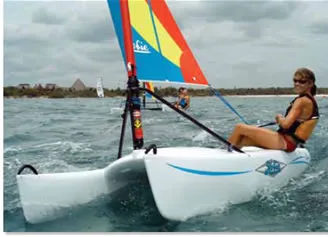
Photo courtesy of Hobie Cat Co.
Eastport Pram
Chesapeake Light Craft expedites boatbuilding for do-it-yourselfers looking to take their garage-built boats for a sail. The company pre-cuts parts, packs kits with all the materials, epoxy, and paint youll need, and leads homebuilders through a thoroughly detailed stitch-and-glue approach to assembly. Kits are available in various stages of completeness, ranging from plans only to the full package, including sail, hardware, running rigging, and paint.
The Eastport Pram is just shy of 8 feet, and the marine plywood and epoxy construction delivers a boat that weighs in, sans sailing rig, at just 62 pounds. Lighter than the comparatively sized Bug, this stiff, durable dinghy, rows like a real boat and sails comfortably with one or two aboard. In keeping with other good tender attributes, the Pram behaves under tow and is equally amicable when propelled by a small outboard or tacked up an estuary under sail.
Kit boatbuilding continues to have a niche following. Theres also an added-value feature worth noting: On one hand, the builder receives a box of pieces and the result of his or her endeavor leads to an aesthetic and utilitarian dinghy. In addition, the DIY skills the builder develops will be useful in other epoxy bonding, brightwork, or mono-urethane application projects. Such talents will benefit many other boat maintenance endeavors.
Whats hard to quantify is the sense of accomplishment derived from sailing a boat that you have built yourself. When the project is tackled in tandem with a child, spouse, or friend, the memories and the boat will last.
Bottom line: With neither sidedecks or a sealed hull, this is not a boat thats easy to recover from a capsize. So once the kids favor on-the-edge sailing in a building breeze, a non swamping, easier-righting boat is probably a better option. The Pram can then be put to use by their appreciative parents or grandparents.
Never in their wildest dreams did Bruce Kirby and Ian Bruce imagine that the Weekender (the Lasers original name) was destined to become an Olympic class sailboat and one of the most popular springboards for top-tier sailors in the world today. Originally envisioned as a car-topper for weekend campers, the cat-rigged, low freeboard sailing dinghy morphed from its original roots into a boat favored by college competitors and revered by generations of agile sailors of all ages. Even frostbiting winter sailors have locked onto the Laser.

Designed in 1969, the Lasers first few years were anything but smooth sailing. Popularity grew quickly, but along with the limelight came plenty of consternation. Dubbed a surfboard not a sailboat by a growing cross-section of the yachting elite-many parents warned junior sailors to steer as clear of Lasers as they did sex, drugs and rock-n-roll. The campaign failed, and junior sailors in yacht club programs around the country fell into the grip of the new one-design dinghy-discovering the sailboats proclivity to plane.

Dyer Dhows languished in boat sheds across the country as a new theme in sailing took hold. Dubbed fast is fun by sailor/engineer Bill Lee, the young Merlin of Santa Cruz, Calif., took the theme to big-boat sailing, merging California culture with the Laser logic of light displacement and planing hull shapes.
Best of all, the Laser embraced the ideal of a tightly controlled one-design class that put people on the water in identical boats and left winning and losing races up to sailing skill and tactics rather than a boats performance edge. For decades, the boat has been the single-handed sailors choice among junior sailing programs, and with the addition of the Radial, 4.7 and M rigs, smaller competitors have also found the boat to be a great sailing platform. Today, theres some lawyer saber-rattling over the sale of the design rights, but the boat remains more popular than ever.
The sleeved sail, two-part spar, daggerboard, and kick-up rudder make the boat a quick-to-rig and fast-to-get underway dinghy. Light-air efficiency is good for a one-design sailboat, but this means that as the breeze builds, the non-reefable sail can become a handful in a hurry. In fact, the boats Dr. Jekyll-and-Mr. Hyde demeanor is what builds talent among Laser practitioners. The big boys block the mainsail and blast off for the layline, while lighter sailors heavy-weather tactics include more nuanced de-powering and feathering. In light air, the tables turn, and the winner is often the sailor who planes quickest on the reaches. The old guards surfboard slam may have held some credence after all.
Bottom line: The Laser is a timeless classic thats easily transported and is built for performance. Its well suited to adrenaline-seeking teens as well as the more fit adult crowd.
Designed in 1947 by Floridian Clark Mills, the utilitarian Optimist could be made out of two sheets of plywood-and from its inception, the Optimist was meant to link kids with the water. Slipping into obscurity in the U.S., the little pram found fertile ground to grow in northern Europe. With just a few tweaks, the Scandinavians took Millss lines and parlayed them into whats become the favored junior sailing trainer for kids from Detroit to Timbuktu. Statistics show that there are about 30 builders worldwide putting out approximately 4,000 boats each year. With about 130,000 boats class registered and an estimated 300,000 total hulls built (amateur and pro), theres plenty of reasons to get excited about an Opti.
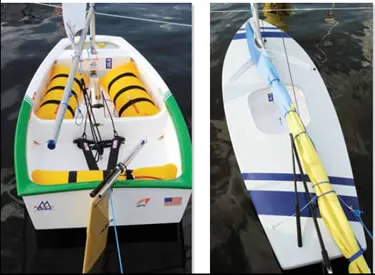
The example weve chosen is the USA-built McLaughlin boat, both a demonstration of high-quality FRP construction and modern manufacturing techniques. Its also a boat that can be purchased in a range of performance-inducing iterations-upgrades designated as club, intermediate, advanced, and professional versions. Like all performance sailboats, stiffness and strength-to-weight ratio is important. But class rules include a minimum weight, so the most competitive hulls meet the mandatory lower limit but use good engineering and building technique to reinforce the daggerboard slot and mast step and produce overall stiffness.

The low mast height and high aspect ratio sprit sail is very versatile, affording young (and small, 65 to 130 pounds) sailors a wide window of decent performance. The flat bottom, slab-sided hull is responsive to crew weight-driven trim changes, and the better the sailor, the more agile they become. Light-air performance is all about minimizing wetted surface and maximizing sail area projection. When the breeze starts to kick up, the sailor becomes the ballast, and the art of hiking, sheet handling, and tiller wiggling come into play.
Under careful adult supervision, two 6- to 8-year-olds can double-hand the friendly little dinghy, or one more-confident child can solo sail it. In fact, introducing kids to sailing with similar proportioned small prams has been a right of passage around for decades. A set of oarlock gudgeons can turn the pram into a functional dinghy thats also adaptable to the smaller Torqeedo outboard (www.torqeedo.com).
McLaughlin also markets a Roto-molded polyethylene version of the Opti and sells DIY kits for those who want to create their own wood version.
Bottom line: The Opti is like a first bicycle without the need for training wheels. The fact that at the last Olympics, over 80 percent of the winning sailors had gotten their start in an Optimist speaks well to the value of messing around in this particular dinghy.

Designed in 1951 by ice boaters Alexander Bryan and Cortland Heyniger, the hard chine Sunfish was the prototype board boat. In 1959, it made the transition into fiberglass, and over the following half-century, more than a quarter-million hulls would hit the water. Simplicity and decent sailing attributes combined with an attractive price to make the Sunfish the most popular one-design dinghy ever raced.
Far more than a platform for racers, these boats are an excellent training tool for sailors of all ages. Also built by Laser Performance, they reflect the fun of summer and put sailors in close contact with the water on which they sail. Its no surprise that the larger fleets coincide with warm water and many see going for a swim to be part and parcel of the low-freeboard experience.
The lateen rig is in keeping with the overall design concept and simplifies rigging. A short stub of a mast is stepped and a single halyard hoists the sail along with tilting V-shaped upper and lower booms.
The total sail area is nearly the same as the Laser, but the halyard hoist versatility of the lateen rig make it a handy beach boat and a little less daunting when the wind begins to build. The clean sail shape on one tack and deformation caused by the mast on the other tack are a slight drawback. The Laser rig is more efficient, but when caught out in a squall, its nice to be able to ease the halyard and dump the sail. Its also handy to be able to leave the boat tethered to a mooring, and the doused sail and short mast make it possible.
Multiple generations of sailors are often found sailing Sunfish, and the boat represents one of the best bargains to be found in the used boat market. When considering a pre owned boat, the potential buyer needs to take a close look at the daggerboard-to-hull junction and mast step, points where previous damage can create hard-to-fix leaks.
Bottom line: The Sunfish is a great beach boat that can turn a hot afternoon into a fun-filled water experience.
There were no losers in this group, and picking winners and runners-up proved a difficult task. The outcome had to be based on assumptions about how these boats would be used. For example, parents with a competitive 9-year-old who swims like a fish, always sprints for the head of the lunch line, and likes to steal bases in Little League probably have an Opti racer in the making. Less competitive junior sailors-future cruisers in the making-will do better learning aboard a Bug. Many newly formed sailing clubs target the boat as their trainer of choice.
The Bravo holds plenty of appeal for those with a lakeside cottage or a favored campground destination. Whether its a solo sail just before sunset or a fun race on Sunday, the quick to set up and put away features are a plus, and for those who feel that two hulls are better-the Bravo will hold plenty of appeal.
Serious competitors can campaign a Laser for life, and whether youre headed for a local district regatta or getting ready for the Olympic trials, the hull, rig, and sail remains identical-sort of like the Monaco Grand Prix being raced in a street legal Mustang.
Bic Opens new little speedster tickled our fancy, and as a trainer/performance boat crossover, it drew a strong nod of approval. Watching the junior sailors smiles as they sailed their Open Bics endorsed our opinion.
And if there is any boat that defines the essence of summer, the Sunfish takes the prize.
- The Art of Building with Thermal-setting Plastics
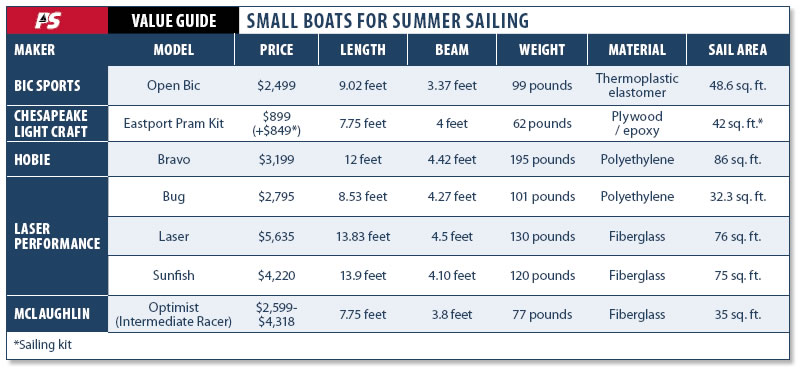
- Youth Safety Gear Top Picks
- Chesapeake Light Craft
- Hobie Cat Co.
- Las er Performance
- McLaughlin Boat Works
RELATED ARTICLES MORE FROM AUTHOR
Leave a reply cancel reply.
Log in to leave a comment
Latest Videos

Island Packet 370: What You Should Know | Boat Review

How To Make Starlink Better On Your Boat | Interview

Catalina 380: What You Should Know | Boat Review
- Privacy Policy
- Do Not Sell My Personal Information
- Online Account Activation
- Privacy Manager
How to Rig a Sunfish Sailboat

Table of Contents
“As an Amazon Associate I earn from qualifying purchases at no additional cost to you”
The Sunfish is arguably the most popular sailboat on the planet. Its popularity is characterized by its inexpensive price, easy portability (probably the only car-toppable sailboat), and easy to rig and sail with just one control line.
But our focus today is on one critical part – how to rig a sunfish. If you just bought your first Sunfish sailboat, sit back and read through this complete step-by-step guide of rigging this kind of dinghy . I hope you already know the parts of a dinghy but if not, well, that’s a topic for another day.
And off we go:
1: Point the sailboat’s bow into the wind. Why? To keep the sail over the Sunfish when it is raised. This will avoid hitting other people or boats with the booms and make it easier to affix the mainsheet.
2: Lay the spars and sail on the sailboat with the mast ring toward the bow.
3: Untie the sail/spar bundle knot and pull the line to undo the bundle. The spars and sail are usually bundled using the mainsheet and halyard.
4: Attach the Boom Sling. Find a spot around fifteen inches below where your halyard meets the upper boom. Pull one side of the Boom Sling around the upper boom and the halyard. Pull the line through the loop to capture the halyard and upper boom. Now, pull the other end of the line to where the lower boom and upper boom meet, and slide the loop over the end of the boom and into the notch formed by the bolt joining the booms.
5: Properly align the mast and boom. Make sure the boom is on the port side of the mast.
6: Ensure the halyard is running directly from the upper boom to the top of the mast and through the hole at the top of the mast.
7: Be sure that the sail is lying towards the port side of the sailboat, and that the mainsheet isn’t wrapped around anything, but just lying below the lower boom.
8: Align the mast, lower and upper booms so that the mast ring is directly over the mast step.
9: Raise the mast and gently place it in the mast step in the deck. Don’t forget to keep hold of the halyard and make sure it’s running neatly through the masthead fairlead from the back to the front.
10: Guide the end of the halyard via the fairlead to starboard of the mast.
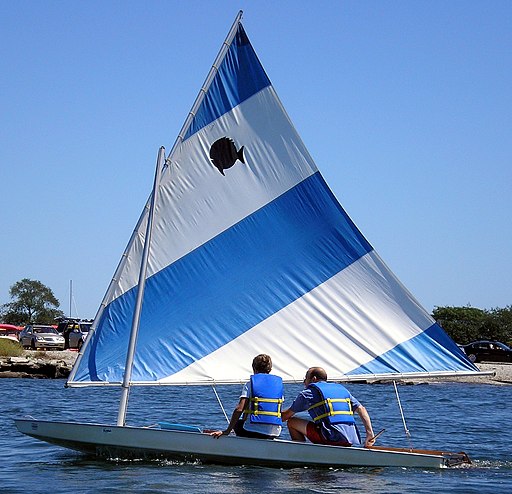
11: Pull the halyard to raise the spar and the sail. Reach down and lift the gooseneck ring so the sail can go all the way to the top of the mast.
12: Tie a cleat hitch in the halyard around 2ft above the cleat and then feed the halyard tail through the cleat hitch and bring it down to fit over the cleat. This helps secure the sail.
13: Ensure the mainsheet runs through all the available sleeves on the boom to stop it from hanging down and catching your neck during tacks and gybes. Tie a cleat knot preferably a figure 8 around the cleat and secure the final turn with an extra twist.
14: Lead the excess halyard tail through the deck fairlead, over the gooseneck and back via the fairlead. Pushing the lower spar down a bit while holding onto the halyard tightly will restrict the spar from rising in harsh winds.
15: Tie another cleat knot on the deck. This one is crucial just in case you capsize as it will keep the sail from falling off the sailboat and sinking. You can tie the extra halyard to the junction of the upper and lower spars with a bowline.
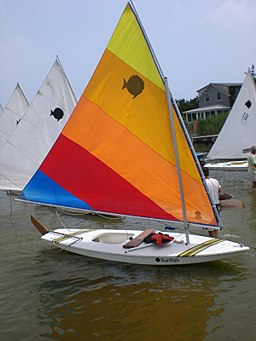
16: Now, run the mainsheet through the ratchet block at the front of the cockpit. Keep in mind that the block only runs in one direction, so be sure to check that first. Tie a stopper knot or figure 8 at the end of the sheet so that it doesn’t get away while you sailing.
17: Tie the other end of the mainsheet to the bridle with a bowline.
18: Fasten the bungee cord affixed to the daggerboard around the mast and then clip it to itself. This is to ensure that the daggerboard stays in the sailboat, as well as supply tension to hold the daggerboard in a partially raised position.
19: Attach the rudder and put the centerboard in its place.
20: Jump in, launch, and go sailing!
And that’s it as far as rigging a Sunfish sailboat is concerned. A piece of advice here is that you need to know at least three types of knots to successfully rig a sailboat: a cleat hitch, a stopper knot or figure 8, and a bowline .
Before you go, let me answer a few frequently asked questions about Sunfish sailboats.
How much is a sunfish sailboat?
A new Sunfish sailboat will set you back at least $4,500 while a used one in good condition will usually fall in the range of $900 to $1,200.
In the case of used boats, there are few things to be keen on. Firstly, a decent used boat should have a smooth hull, uniformly firm with no soft areas, and without deep imperfections or holes.

from PxHere
Secondly, the sailboat ought to be dry sailed, meaning it must have been stored on land, off the ground, and under proper shelter throughout the time when it was not being used. The reasoning behind this is that boats left in water or carelessly stored gain weight quickly, and weight is something you want to keep at a minimum when sailing. I won’t recommend a used Sunfish for competitive sailing unless it’s within a few kilograms of the weight of a new one.
How fast can a sunfish sailboat go?
Now, let’s first be clear that ‘fast’ is always relative because different factors come into play to determine how fast you can go. For instance, a general rule of thumb has it that a lighter boat sails faster than a heavy one. Also, a longer sailboat will record a higher maximum speed than a shorter boat.
What’s more? Boats tend to sail slower in cold waters than in warm waters, and shallow waters decrease boat speed too as the vessel sinks more and has to displace more water out of its way.
Another thing to remember is that Sunfish sailboats are casual-style boats, and so you might want another option if you’re after the need for speed. All in all, a sunfish sailboat can clock 11 knots in favorable conditions. Keep in mind that the official Laser sailboat speed record is 16.8 knots, and Lasers tend to be faster than Sunfish.
How heavy is a sunfish sailboat?
A new Sunfish is typically 120 pounds (54kg).
How to transport a Sunfish sailboat?
Nearly all Sunfish sailboats are cartoppable, thanks to their small and lightweight designs. Simply install the right equipment on the top of your car, such as roof rack and straps, and you’ll find it a doddle transporting your Sunfish. Alternatively, you can buy a trailer and it will save you the work of loading and taking down your sailboat.
How to clean a sunfish sailboat?
Now there’s no formula on how to clean a Sunfish sailboat or any sailboat for that matter. But let me give a few tips on how I do it. I realized that beginning from the topmast to the sails and down to the keel is pretty efficient. Be sure to use non-harmful detergents too.
To clean the sail, first set it down on a clean, flat area. Add some liquid detergent into a bucket of warm water and brush the sail gently to remove debris. You can also clean the sail with your hands, though this process is time-consuming.
As for the hull, I tend to use a pressure washer with a gentle nozzle to remove the worst of the dirt. I then mix a bucket of water and laundry detergent and wash the entire hull using a scrubber or kitchen sponge. Next up is rinsing the whole thing using a clean sponge and plenty of clean water after which I let it dry. Note that your hull (especially fiberglass) might require extra maintenance depending on how dirty and greased it is. Perhaps an extra polish or wax to keep looking nice.
The mast and boom can always do with some scrubbing with soapy water and giving them a good rinse. Bleach can be used to remove tough stains such as mildew.
To cut a long story short, most cleaning involves the use of soapy water, a mild detergent, and a sponge. Just make sure to follow instructions as per the cleaner of your choice.
The Sunfish sailboat is loved by all and the small matter of how to rig a Sunfish is now done and dusted. When the wind is good, just take to the water and have fun zipping about. If you have any additional questions or feedback, feel free to leave a comment below.

PS: Interested in the best drysuits for dinghy sailing ? Check out our guide here!
Happy sailing!

Bill is an ISA Sailing & Powerboating Instructor in Ireland. He writes about all things sailing.
Related Articles that might be of interest to you:

The 5 Best Spray Guns for Awlgrip Paint
“As an Amazon Associate I earn from qualifying purchases at no additional cost to you” If your boat is looking a bit worse for wear and you want to put some new life on your old sail or motorboat, then chances are you’re going to be using Awlgrip paint to

The 5 Best Shoes for Dinghy Sailing – Expert’s Guide
“As an Amazon Associate I earn from qualifying purchases at no additional cost to you” Answering the call of adventure by dinghy sailing requires you have all the right equipment at hand. You cannot go dinghy sailing with a pair of office shoes; you need proper water shoes that work

The 37 Best Sailing Movies [ Ultimate Guide + Ratings]
“As an Amazon Associate I earn from qualifying purchases at no additional cost to you” The ocean is a vast and beautiful place. It contains many mysteries that the human race has yet to solve. The sea can be calming, or it can be deadly. The sea surrounds us with
Leave a Comment Cancel Reply
Your email address will not be published. Required fields are marked *
- Techniques & Guides
- Yacht Equipment
- Personal Gear
Made by Dancing Data.
Disclosure . Terms and Conditions . Privacy Policy
Great choice! Your favorites are temporarily saved for this session. Sign in to save them permanently, access them on any device, and receive relevant alerts.
- Sailboat Guide
Super Sunfish
Super Sunfish is a 13 ′ 10 ″ / 4.2 m monohull sailboat designed by Alexander Bryan/Cortland Heyniger/Carl Meinart and built by AMF Corp. and Alcort between 1974 and 1984.
Rig and Sails
Auxilary power, accomodations, calculations.
The theoretical maximum speed that a displacement hull can move efficiently through the water is determined by it's waterline length and displacement. It may be unable to reach this speed if the boat is underpowered or heavily loaded, though it may exceed this speed given enough power. Read more.
Classic hull speed formula:
Hull Speed = 1.34 x √LWL
Max Speed/Length ratio = 8.26 ÷ Displacement/Length ratio .311 Hull Speed = Max Speed/Length ratio x √LWL
Sail Area / Displacement Ratio
A measure of the power of the sails relative to the weight of the boat. The higher the number, the higher the performance, but the harder the boat will be to handle. This ratio is a "non-dimensional" value that facilitates comparisons between boats of different types and sizes. Read more.
SA/D = SA ÷ (D ÷ 64) 2/3
- SA : Sail area in square feet, derived by adding the mainsail area to 100% of the foretriangle area (the lateral area above the deck between the mast and the forestay).
- D : Displacement in pounds.
Ballast / Displacement Ratio
A measure of the stability of a boat's hull that suggests how well a monohull will stand up to its sails. The ballast displacement ratio indicates how much of the weight of a boat is placed for maximum stability against capsizing and is an indicator of stiffness and resistance to capsize.
Ballast / Displacement * 100
Displacement / Length Ratio
A measure of the weight of the boat relative to it's length at the waterline. The higher a boat’s D/L ratio, the more easily it will carry a load and the more comfortable its motion will be. The lower a boat's ratio is, the less power it takes to drive the boat to its nominal hull speed or beyond. Read more.
D/L = (D ÷ 2240) ÷ (0.01 x LWL)³
- D: Displacement of the boat in pounds.
- LWL: Waterline length in feet
Comfort Ratio
This ratio assess how quickly and abruptly a boat’s hull reacts to waves in a significant seaway, these being the elements of a boat’s motion most likely to cause seasickness. Read more.
Comfort ratio = D ÷ (.65 x (.7 LWL + .3 LOA) x Beam 1.33 )
- D: Displacement of the boat in pounds
- LOA: Length overall in feet
- Beam: Width of boat at the widest point in feet
Capsize Screening Formula
This formula attempts to indicate whether a given boat might be too wide and light to readily right itself after being overturned in extreme conditions. Read more.
CSV = Beam ÷ ³√(D / 64)
The SUPER SUNFISH is a version of the standard SUNFISH offered with an unstayed cat rig. A kit was also available to use on an existing SUNFISH. The idea had developed a few years earlier using a slightly more complex rig (FORMULA S). AMF adopted this, their own version, which was availble for 10 years beginning in 1974. The smaller MINIFISH was available with a similar option.
Embed this page on your own website by copying and pasting this code.
- About Sailboat Guide
©2024 Sea Time Tech, LLC
This site is protected by reCAPTCHA and the Google Privacy Policy and Terms of Service apply.
Mastering The Art Of Rigging Sunfish For Optimal Performance
- Last updated Dec 08, 2023
- Difficulty Intemediate
- Category Sunfish
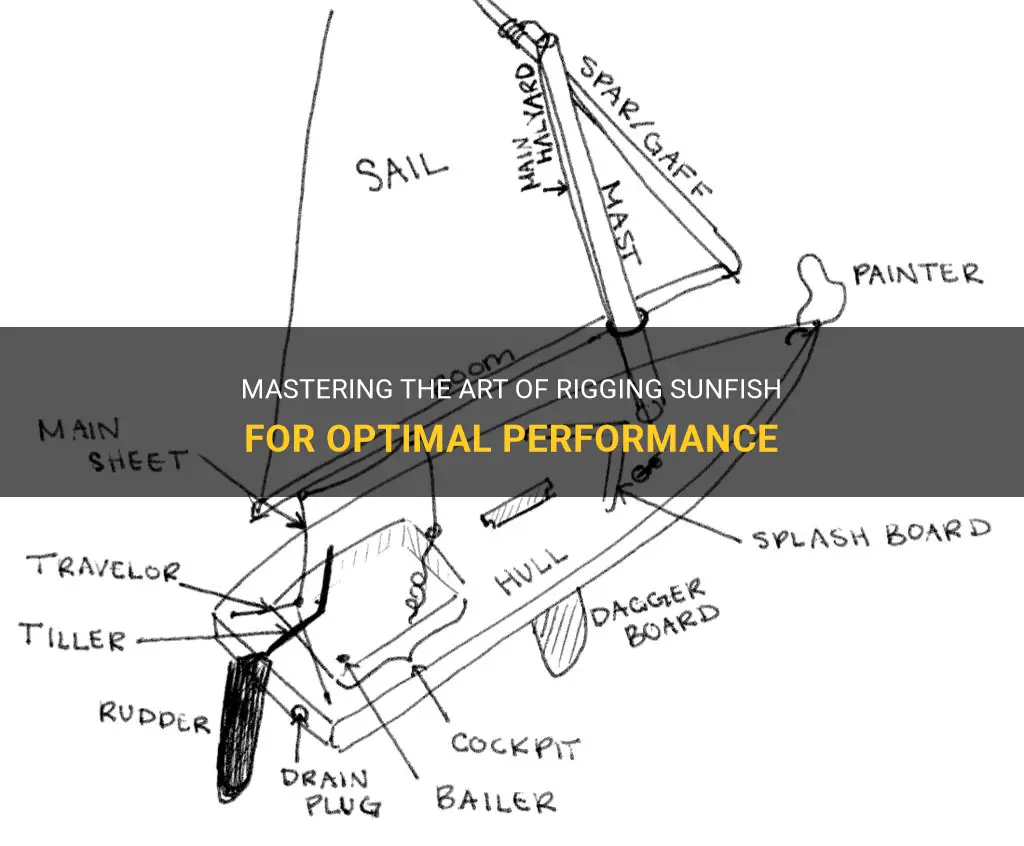
If you're an avid sailor or a beginner looking for a fun and easy-to-handle boat, the Sunfish is a fantastic choice. With its simple rigging system, this small sailboat is perfect for both recreational sailing and competitive racing. Rigging a Sunfish may seem daunting at first, but fear not! In this guide, we'll walk you through the step-by-step process of rigging your Sunfish, ensuring that you're ready to set sail in no time. So grab your sunscreen, hop aboard, and let's get rigging!
What You'll Learn
What are the necessary steps to rig a sunfish sailboat, how do you properly attach the sail to the sunfish mast, what is the best way to rig the sunfish boom and attach it to the mast, are there any specific techniques or tips for tightening the sail on a sunfish, what are the key components of a sunfish rigging system and how do they work together.

Rigging a Sunfish sailboat is not a difficult task, but it does require some careful steps to ensure that everything is set up correctly. Whether you are a beginner or an experienced sailor, it is important to understand the process so that you can enjoy a safe and successful sail. In this article, we will provide you with a step-by-step guide on how to rig a Sunfish sailboat.
Before we begin, let's briefly discuss the basic components of a Sunfish sailboat. The Sunfish has a triangular lateen sail, which is attached to a mast. The mast is held up by a set of stays and shrouds, and the sail is controlled by a main sheet and a rudder. Now, let's jump into the rigging process!
Step 1: Prepare your equipment
Before rigging your Sunfish sailboat, gather all the necessary equipment. This includes the mast, boom, sail, rudder, tiller, main sheet, and all the lines and fittings. Also, make sure you have all the tools required for assembly, such as a screwdriver or wrench.
Step 2: Attach the mast and boom
Start by attaching the mast to the boat. Insert the bottom end of the mast into the mast step, which is a hole located in the front of the boat near the bow. Make sure the mast is securely in place. Next, attach the boom to the mast. The boom is the horizontal pole that holds the foot of the sail. Insert one end of the boom into the gooseneck fitting on the mast and secure it with a pin or clip.
Step 3: Attach the sail
Unfold the sail and hoist it up the mast. The top of the sail should be attached to the masthead fitting using a halyard. Make sure the sail is centered and straight before hoisting it all the way up. Secure the halyard to the masthead and tighten it to hold the sail in place. Adjust the tension of the halyard to suit the wind conditions.
Step 4: Rig the control lines
Next, you need to rig the control lines for the sail. The main sheet controls the angle and tension of the sail and is attached to the boom. Attach one end of the main sheet to the eye strap on the boom, and run it through the block at the back of the boat. Make sure the sheet is not tangled or twisted, and adjust the length to a comfortable reach. The rudder controls the direction of the boat and is connected to the tiller. Make sure the rudder is securely attached to the transom of the boat and adjust the length of the tiller extension for easy steering.
Step 5: Check the rigging
After completing all the steps, double-check that everything is properly rigged and secure. Make sure the mast, boom, and sail are all properly attached and tensioned. Check that the control lines are correctly run and are not tangled or obstructed. Lastly, inspect the rigging hardware for any signs of wear or damage, and replace or repair as necessary.
Congratulations! You have successfully rigged your Sunfish sailboat. Now it's time to hit the water and enjoy a great sailing experience. Remember, safety should always be your top priority, so be sure to wear a life jacket and follow all sailing regulations. Happy sailing!
Exploring the Palatable Delights of Sunfish: Do They Taste as Good as They Look?
You may want to see also
Attaching the sail to the Sunfish mast is an important step in preparing your Sunfish sailboat for sailing. The proper attachment of the sail ensures that it will catch the wind efficiently and provide you with maximum propulsion. In this article, we will provide step-by-step instructions on how to properly attach the sail to the Sunfish mast.
Step 1: Prepare the sail and mast
Before attaching the sail to the mast, make sure both the sail and the mast are clean and free from any debris. Inspect the sail for any tears or damage, and repair them if necessary.
Step 2: Insert the mast into the sail sleeve
The Sunfish sail consists of a sleeve that runs along the mast. Start by inserting the bottom end of the mast into the sleeve at the bottom of the sail. Carefully slide the mast upwards, ensuring that the sleeve is aligned with the mast.
Step 3: Secure the sail to the mast step
The mast step is the hole at the hull of the Sunfish where the mast sits. Once the mast is inserted into the sail sleeve, angle the mast so that it is perpendicular to the deck. Insert the mast into the mast step and make sure it is securely seated.
Step 4: Attach the halyard to the head of the sail
The halyard is a rope or line that is used to hoist and lower the sail. Locate the head of the sail, which is the top corner. Run the halyard through the grommet at the head of the sail and secure it with a knot or cleat.
Step 5: Tension the halyard
Once the halyard is attached, gently pull on the halyard to raise the sail. Make sure the sail is tensioned properly by adjusting the halyard. The sail should be taut and not loose or sagging.
Step 6: Secure the sheet to the clew of the sail
The sheet is another rope or line that is used to control the angle of the sail relative to the wind direction. Locate the clew of the sail, which is the bottom corner opposite the head. Attach the sheet to the clew with a bowline knot or a similar secure knot.
Step 7: Check the sail alignment
Once the sail is attached, visually inspect it to ensure proper alignment. The luff, or leading edge of the sail, should be running straight up the mast. The leech, or trailing edge, should be parallel to the centerline of the boat.
Step 8: Secure the boom
The boom is the horizontal spar that runs along the foot of the sail. Make sure the boom is properly attached to the mast and is secured with the appropriate fittings. Adjust the boom height and angle as necessary.
By following these step-by-step instructions, you can ensure that your Sunfish sail is properly attached to the mast. This will not only maximize the sailboat's performance but also enhance your overall sailing experience. Remember to always check the rigging and sail setup before heading out on the water to ensure a safe and enjoyable sail.
Exploring the Culinary Delights of Redear Sunfish: A Guide to Eating These Tasty Freshwater Fish
Rigging the Sunfish boom, which is an important part of the sailing rig, is crucial for a successful day on the water. The boom is responsible for controlling the position of the mainsail, and proper rigging ensures effective sail control and improved boat handling. In this article, we will discuss the best way to rig the Sunfish boom and attach it to the mast, taking into consideration scientific principles, personal experience, step-by-step instructions, and examples.
Scientifically, the placement and attachment of the Sunfish boom to the mast affect the sail's shape and efficiency, which ultimately impacts the boat's performance. The boom should be positioned at a height that allows the sail to achieve the desired shape, avoiding excessive curvature or flapping. This ensures that the sail catches the wind effectively, providing thrust and maneuverability. The angle at which the boom is attached to the mast also affects the overall sail profile and the boat's stability. Therefore, it is important to consider these scientific principles while rigging the Sunfish boom.
Based on personal experience and expertise, which is invaluable in sailing, the following step-by-step instructions outline the best way to rig the Sunfish boom and attach it to the mast:
- Begin by inserting the gooseneck, a fitting that connects the boom to the mast, into the hole located at the bottom of the mast.
- Slide the boom into the gooseneck, ensuring that it is aligned correctly. The boom should be parallel to the deck and centered between the sides of the boat.
- Secure the boom to the gooseneck using the boom vang, a control line that helps control the position and tension of the boom. Attach one end of the boom vang to the boom, near the middle, and the other end to the mast fitting located near the base of the mast.
- Adjust the tension of the boom vang to achieve the desired sail shape. This can be done by tightening or loosening the control line until the desired amount of tension is achieved.
- Attach the mainsail to the boom by sliding the luff, or leading edge of the sail, into the groove on the boom. Ensure that the sail is evenly tensioned and smooth without any wrinkles or creases.
- Secure the mainsail to the boom using sail ties or cleats. It is essential to ensure that the sail is properly attached to the boom to prevent any unintended shifting or flapping while underway.
By following these step-by-step instructions, you can effectively rig the Sunfish boom and attach it to the mast, setting yourself up for a successful sailing experience.
To further illustrate the best way to rig the Sunfish boom, let's consider an example. Imagine you are preparing to go sailing on a sunny day. You have your Sunfish ready, and you want to rig the boom correctly to ensure optimal sail control. By following the steps outlined above, you confidently insert the gooseneck into the mast, align the boom parallel to the deck, and attach it securely using the boom vang. You then attach the mainsail to the boom, ensuring it is evenly tensioned and smooth. Finally, you secure the sail to the boom to prevent any unintended shifting. With everything correctly rigged, you set sail and enjoy a smooth, controlled ride, utilizing the best way to rig the Sunfish boom.
In conclusion, rigging the Sunfish boom is essential for effective sail control and improved boat handling. Applying scientific principles, personal experience, step-by-step instructions, and examples, we have outlined the best way to rig the Sunfish boom and attach it to the mast. By following these guidelines, you can ensure optimal sail shape, sail control, and a successful day of sailing.
Choosing the Right Size Hook for Sunfish: A Guide to a Successful Fishing Experience
Are you a proud owner of a Sunfish sailboat? If so, you may be wondering how to properly tighten the sail for optimal performance on the water. In this article, we will discuss some specific techniques and tips for tightening the sail on a Sunfish.
Tightening the sail on a Sunfish is crucial for achieving maximum speed and control. A tight sail helps to reduce flapping and allows the wind to flow smoothly across the surface, generating lift and propulsion. Here are some techniques to help you achieve the perfect sail tension:
- Adjust the halyard: The halyard is the line that raises and lowers the sail. Start by loosening the halyard completely. Then, gradually tighten the halyard while observing the shape of the sail. Ideally, you want the sail to have a slight curve or belly in the middle, known as "draft," which helps generate lift. However, be careful not to overtighten the halyard, as it may cause the sail to become too flat and lose power.
- Use the cunningham: The cunningham is a control line that is attached to the front of the sail and can be used to further tension the sail. By pulling on the cunningham, you can flatten the sail and reduce the draft, which is useful in stronger winds. Experiment with different cunningham tension settings to find the optimal shape for the prevailing wind conditions.
- Adjust the boom vang: The boom vang is a line that controls the angle of the boom relative to the mast. A properly adjusted boom vang helps to maintain leech tension, which is the back edge of the sail. This tension plays a crucial role in controlling the shape of the sail and preventing flapping. Ensure that the vang is adjusted enough to keep the leech of the sail tight, but not so much that it overly flattens the sail.
- Check the downhaul: The downhaul is a line that controls the tension along the foot of the sail. It helps to stretch the lower part of the sail and pull the draft forward, improving the overall shape. Make sure the downhaul is snug but not overly tight, as excessive tension can distort the sail's shape and hinder performance.
In addition to these techniques, there are a few more tips to keep in mind when adjusting the sail tension on a Sunfish:
- Take note of the wind conditions: Different wind strengths require different sail tensions. In light winds, you may want to have a deeper draft for more power, while in stronger winds, you may want to flatten the sail for better control.
- Regularly inspect and maintain your sail: Check for any tears, loose stitching, or wear and tear on your sail. A well-maintained sail performs better and is easier to tighten properly.
- Practice and experiment: Finding the perfect sail tension is often a matter of trial and error. Spend time on the water experimenting with different settings and observing how the boat performs. Keep track of the adjustments you make and their effects to develop a better understanding of your boat's optimal sail tension.
- Seek advice from experienced sailors: If you are new to sailing or want to further improve your skills, consider reaching out to experienced Sunfish sailors or attending local sailing clinics. Learning from experienced sailors can provide valuable insights and guidance on adjusting the sail tension for optimal performance.
In conclusion, properly tightening the sail on a Sunfish is essential for achieving optimal performance on the water. By following the techniques and tips outlined in this article, you can fine-tune the sail tension to maximize speed, control, and overall sailing enjoyment. Remember to adjust the halyard, cunningham, boom vang, and downhaul, while considering the wind conditions and maintaining your sail. With practice and experimentation, you will become a master at achieving the perfect sail tension for your Sunfish sailboat.
The Sunfish sailboat is a classic, one-design sailboat that is popular for recreation and racing. Its simple rigging system is a key component of its success, as it allows for easy setup and sailing. In this article, we will explore the key components of a Sunfish rigging system and how they work together to create a balanced and efficient sailing experience.
The mast is the central component of the Sunfish rigging system. It is a tall, aluminum pole that supports the sail and provides stability to the boat. The mast is typically held in place by a mast step, which is a fitting on the deck of the boat that holds the bottom of the mast securely.
Attached to the mast is the sail, which is the main driving force of the boat. The Sunfish sail is a lateen rig, meaning it is triangular in shape and attached to a yard, a horizontal spar that extends along the bottom edge of the sail. The yard is attached to the mast using a halyard, a line that raises and lowers the sail. The halyard is typically controlled by a cleat, a device that holds the line in place when it is tensioned.
The boom is another important component of the Sunfish rigging system. It is a horizontal spar that extends aft from the mast and supports the bottom edge of the sail. The boom is attached to the mast using a gooseneck, a fitting that allows for movement and adjustment of the boom. The boom is controlled by a mainsheet, a line that is used to control the angle of the boom and the trim of the sail. The mainsheet is typically controlled by a cleat or a block and tackle system, which allows for easy adjustment and fine-tuning of the sail.
In addition to the main components, there are several other lines and fittings that are used to control the sail and rigging of the Sunfish. The outhaul is a line that is used to adjust the tension on the foot of the sail, allowing for fine-tuning of the sail's shape. The cunningham is a line that is used to adjust the tension on the luff of the sail, allowing for further control of the sail's shape and performance. The downhaul is a line that is used to tension the boom and maintain control over the sail in high winds. These lines are typically controlled by cleats or blocks, allowing for easy adjustment and control.
When all of these components are properly set up and adjusted, they work together to create a balanced and efficient sailing experience. The mast supports the sail, providing stability and control. The boom allows for adjustment of the sail's angle and trim, maximizing its power and efficiency. The various lines and fittings allow for easy adjustment and fine-tuning of the sail, allowing the sailor to adapt to changing wind and water conditions.
In conclusion, the key components of a Sunfish rigging system are the mast, sail, boom, and various lines and fittings. When these components are properly set up and adjusted, they work together to create a balanced and efficient sailing experience. Whether you are a recreational sailor or a competitive racer, understanding and mastering the Sunfish rigging system is essential for getting the most out of your sailing experience.
Frequently asked questions
Certainly! To rig a sunfish sailboat, start by attaching the mast to the mast step at the front of the boat. Insert the mast into the hole on the mast step and secure it with the mast step pin. Next, attach the boom to the gooseneck at the bottom of the mast. Slide the gooseneck over the mast and tighten the boom vang to hold it in place. Then, attach the mainsail to the mast and boom, making sure the halyard is securely fastened. Lastly, hoist the sail by pulling the halyard rope and tighten the sail controls as necessary.
To secure the daggerboard in a sunfish sailboat, start by inserting the daggerboard into the daggerboard trunk, which is located in the middle of the cockpit. Push the daggerboard down until it is fully inserted, then use the locking pin or thumb screw to secure it in place. Make sure the daggerboard is positioned perpendicular to the boat for optimal performance.
The hiking strap in a sunfish sailboat is used to help the sailor maintain balance and stability while sailing. It is a strap that is attached to the port and starboard sides of the cockpit and is designed to be used as a foothold. By placing their feet in the hiking strap, sailors can lean out over the side of the boat to counterbalance the force of the wind in the sail.
Properly trimming the sails on a sunfish sailboat is crucial for optimal performance. To trim the sails, adjust the main sheet, which controls the angle of the mainsail. Pull the main sheet in to trim the sail for more power or let it out to ease the sail for less power. Additionally, use the cunningham and outhaul controls to adjust the tension of the sail and optimize its shape. Experiment with different settings to find the best trim for your sailing conditions.
When rigging a sunfish sailboat, it's important to prioritize safety. Always wear a personal floatation device (PFD) when sailing. Inspect all equipment before rigging to ensure it is in good working condition. Be mindful of any overhead obstacles, such as power lines or tree branches, when raising the mast. Finally, be aware of weather conditions and only sail in appropriate conditions for your skill level.

- Andy Walters Author

- Mark Terry Author Editor Reviewer
It is awesome. Thank you for your feedback!
We are sorry. Plesae let us know what went wrong?
We will update our content. Thank you for your feedback!
Leave a comment
Sunfish photos, related posts.

Understanding the Legal Seasons for Fishing Sunfish in Minnesota
- Dec 09, 2023

The Dietary Habits of Blue Spotted Sunfish: What Do They Eat?

Exploring the Mechanisms: How Sunfish Locate Prey

Is it Legal to Keep Sunfish as Pets in Georgia?

The Mysterious Decline: Investigating the Alarming Sunfish Mortality in My Local Lake

Factors to Consider When Buying a Fiberglass Sunfish Hull

Is a Laser Sailboat Faster Than a Sunfish?

Last Updated by
Daniel Wade
August 30, 2022
Solo sailing for races requires a fast boat, with two models coming to mind. You might be wondering, is a Laser faster than a Sunfish?
Both of those sailboats provide an enjoyable ride, are fast, and have their positives. But which one is faster when it matters the most?
Laser sailboats are faster than Sunfishes and are easier to handle out of the two. Professional sailors often race with a Laser since its design allows it more speed for its size. As for Sunfishes, they are lightweight and fast, but they are more of a recreational boat.
If you were trying to purchase one of the two for everyday use, the Sunfish is a great option. But if you want an opportunity to win races with a similar boat size, then a Laser is your best bet.
According to experts in the industry, the Laser is by far the faster boat of the two. In fact, they use the Laser in Olympic races and continue to plan ahead with the schedule with that particular boat.
Table of contents
Differences Between a Laser and Sunfish
A Laser and a Sunfish are not entirely different since they are made of the same materials and are about the same size. A Laser sailboat is great for newbies or even children wanting to learn how to sail. Out of the two, it is more nimble and has a better chance at going faster while sailing.
As for the Sunfish , it has similarities compared to a Laser. However, it is best reserved to be a recreational boat instead of a racer. While the Laser is easier to handle, the Sunfish is not that bad to handle either.
If you want speed, the Laser is by far the faster boat if the two were to go head to head. Assuming the person sailing both boats are professionals, the Laser handles upwind much better and will dominate in a head to head competition against a Sunfish.
Buy a Sunfish or a Laser?
There are a few factors that come into play for purchasing either a Sunfish or a Laser. It is completely understandable if you find a good deal on either one and decide to go for that option, but you must figure out your sailing goals.
Your sailing goals, whether it is to have a good time or to race, need to be addressed before you make a final decision. Both boats are designed for specific purposes, so it is important to know what you want and why.
Best for Newbies or Children
If you have a small child or someone that wants to learn how to sail, then the Laser is the best option. Lasers allow the perfect setting to get started with sailing since they are lightweight and easy to operate.
With the Sunfish, this boat is best for one person navigating the other just enjoying the ride. While not complicated to operate a Sunfish, the Laser is just easier. The Laser is slightly wider than a Sunfish by about five inches, so an extra person on board might be easier to handle here.
More Stability
While this should not be alarming for these types of sailboats, you are going to get wet. In fact, both these boats are considered “wet boats” since you are just inches away from the water and you have the chance of capsizing.
On a majority of boats, this is bad news. However, capsizing on a dinghy is part of the process when trying to learn how to race them.
If you do capsize, do not worry about your boat. They both have self-bailing systems in place to help remove water from the cockpit.
Lasers can be a bit touchy when trying to navigate since they respond with weight shifts in the boat. Even though they can be easier to navigate, you are likely to capsize more often in these than a Sunfish.
Sunfish boats are less likely to capsize since their design is meant to be recreational, whereas the Laser is a racer and is capable of this more often. If you want more time enjoying the sun while sailing, the Sunfish is better in this regard.
Overall Cost
Finding a good deal on either sailboat is part of the process and could make the biggest impact on your decision. Your sailing goals are a priority when making a decision about what works best for you, but the price is also important to consider.
A brand new Sunfish can range up to $5,500 for their performance package, while other models cost about $4,000. If you find a used one, these can range between $500 to $2,000 depending on condition and age.
A brand new Laser can range up to $5,800, with some packages offering around $5,100. A used one is likely the best for any budget, as these vary between $1,500 and $3,000 based on condition.
When looking at a used version of either boat, you want to make sure the hull is in good shape with very few imperfections. It needs to be firm, without any soft spots, or you risk it taking on water in the future.
While this will be difficult to potentially get an honest answer for a used version, you need to ask how the boat was stored when not in use. The best way to keep it in its condition is when it is dry and covered. If the boat has been in the water for some time in the elements, it could potentially gain weight and fall apart later after use.
You need to check the weight of the used boat you are purchasing too. Both the Sunfish and Laser have weights of about 130 pounds.
In addition, the condition of the sails needs to be considered before buying. New Laser sails can cost up to $700, while new sails on the Sunfish vary around $450.
As you can see, both sailboats can be afforded if your budget is in shape. They both cover the same areas in price, so it likely does not matter a lot when trying to buy one unless you find a good deal.
Ease of Use
Both sailboats are simple and easy to use, with some exceptions. Both have different amounts of sail controls to operate but are still easy to use.
The Sunfish is a straightforward operation with just a few controls to play with. This makes it one of the more popular boats to exist as a recreational dinghy.
For the Laser, it usually has around five different controls to mess with and can be overwhelming at first for a small child. However, it is easy to learn and anyone can catch on quickly.
No matter which one you choose, they both make it easy to operate. You just need to see which one fits your style of sailing.
Both the Sunfish and Laser are made out of fiberglass, so you do not have to worry about wood being the base of the boat. With that said, there are not really any differences to what each boat is made of.
The part that matters is the condition of the boat if you decide to buy one used. Fiberglass is easier to clean and maintain, but you need to know how to work on it if you find one that needs repairs.
Setup Times
Both boats are easy to set up in and out of the water. By just a few minutes, the Sunfish is slightly easier to get going versus the Laser.
It takes roughly 20 minutes to get everything going for the Laser, assuming you have a routine down. If you want to save a few minutes of time preparing for your sailing trip, the Sunfish is the slightly better option.
Related Articles
I've personally had thousands of questions about sailing and sailboats over the years. As I learn and experience sailing, and the community, I share the answers that work and make sense to me, here on Life of Sailing.
by this author
Most Recent

What Does "Sailing By The Lee" Mean?
October 3, 2023

The Best Sailing Schools And Programs: Reviews & Ratings
September 26, 2023
Important Legal Info
Lifeofsailing.com is a participant in the Amazon Services LLC Associates Program, an affiliate advertising program designed to provide a means for sites to earn advertising fees by advertising and linking to Amazon. This site also participates in other affiliate programs and is compensated for referring traffic and business to these companies.
Similar Posts

How To Choose The Right Sailing Instructor
August 16, 2023

Cost To Sail Around The World
May 16, 2023

Small Sailboat Sizes: A Complete Guide
October 30, 2022
Popular Posts

Best Liveaboard Catamaran Sailboats
December 28, 2023

Can a Novice Sail Around the World?
Elizabeth O'Malley
June 15, 2022

4 Best Electric Outboard Motors

How Long Did It Take The Vikings To Sail To England?

10 Best Sailboat Brands (And Why)
December 20, 2023

7 Best Places To Liveaboard A Sailboat
Get the best sailing content.
Top Rated Posts
Lifeofsailing.com is a participant in the Amazon Services LLC Associates Program, an affiliate advertising program designed to provide a means for sites to earn advertising fees by advertising and linking to Amazon. This site also participates in other affiliate programs and is compensated for referring traffic and business to these companies. (866) 342-SAIL
© 2024 Life of Sailing Email: [email protected] Address: 11816 Inwood Rd #3024 Dallas, TX 75244 Disclaimer Privacy Policy

IMAGES
VIDEO
COMMENTS
The Sunfish is a personal-size, beach-launched sailing dinghy.It features a very flat, boardlike hull carrying an Oceanic lateen sail mounted to an un-stayed mast.. Sunfish was developed by Alcort, Inc. and first appeared around 1952 as the "next generation" improvement on their original boat, the Sailfish.In contrast, the Sunfish has a wider beam for more stability, increased freeboard and ...
Jan 9, 2019. #2. The hull speed of a displacement hull is 1.34 x the square root of the waterline length. If the loaded waterline length of your sunfish is about 13' (LOA is 13'9") then the hull speed is under 5 knots. However, a sunfish will go up on plane, so it's not really limited by the hull speed. It takes some extra energy to get a hull ...
The Sunfish sailboat, known for its simplicity, affordability, ... Experimenting with different trim settings will help you find the optimal balance between speed and control. ... Position the sail perpendicular to the wind for maximum power. - Sail shape: Adjust the sail's shape using the cunningham, ...
Sunfish is a 13′ 10″ / 4.2 m monohull sailboat designed by Alexander Bryan/Cortland Heyniger/Carl Meinart and built by AMF Corp., Alcort, Pearson Yachts, and LaserPerformance starting in 1952. ... The theoretical maximum speed that a displacement hull can move efficiently through the water is determined by it's waterline length and ...
Sunfish Builder Chronology. 1952 - 1969 Alcort, Inc. (founded 1945) 1969 - 1986 AMF. 1986 - 1988 Loveless & DeGarmo, dba, Alcort Sailboats Inc. 1988 - 1991 Pearson Yacht Co. 1991 - 1997 Sunfish/Laser, Inc. 1997 - 2007 Vanguard. 2007 - Laser Performance. Change in class rules permitted a new, slightly deeper daggerboard in the mid-1990's.
Typical Speed Range. So, how fast can you sail a Sunfish? While it ultimately depends on various factors mentioned earlier, a well-sailed Sunfish can typically reach speeds between 4 and 6 knots (4.6 - 6.9 mph or 7.4 - 11.1 km/h). Note: These values are approximate and may vary depending on conditions and individual sailing skills.
Reckless Rudy. New Member. I just got home from sailing in 15 mph winds on a small (1 mile diameter) lake and I have a SpeedMate installed on my fish. It recorded a max speed of 8.55 knots or 9.8 mph. I know I've sailed faster than that prior to installing the SpeedMate. Aug 5, 2004.
Balancing the forces on a Sunfish sailboat is crucial for maximum speed and control. To achieve this, you can adjust the sail's center of effort by moving it in relation to the hull. Lowering the sail on the mast helps reduce heeling and allows for better control by hiking out. Adjusting the gooseneck on the boom moves the sail forward and ...
The Sunfish has had a low price point and is easily portable for over fifty years. It is very easy to set up, has decent speed with the right wind, and allows you to beach it. It is great for beginners, but experienced sailors will love the simplicity of it. As with all sailboats, there are definitely some negatives to owning a Sunfish.
A Sunfish sailboat is a small, single-handed sailing dinghy popular for recreational and competitive sailing. What is a Sunfish Sailboat? It is designed to be simple and easy to maneuver, making it ideal for beginners and experienced sailors. The Sunfish sailboat has a unibody construction with a cockpit for the sailor and a single triangular ...
Process of Stepping the Mast, Which Involves Attaching the Mast to the Boat's Hull. Stepping the mast is a crucial step in rigging your Sunfish. Follow these steps carefully: Attach the Mast Step: The mast step is a metal fitting on the boat's deck near the bow. Insert the bottom end of the mast into the mast step.
Sailing a Sunfish requires a combination of physical and mental skills. ... Finally, it's important to properly harness the power of the wind for maximum speed and control. When sailing upwind, try to keep the boat as flat as possible by adjusting the daggerboard and hiking out (leaning out over the side of the boat) to counteract the ...
The low mast height and high aspect ratio sprit sail is very versatile, affording young (and small, 65 to 130 pounds) sailors a wide window of decent performance. The flat bottom, slab-sided hull is responsive to crew weight-driven trim changes, and the better the sailor, the more agile they become.
The Sunfish is a small sailboat that's designed for one or two people, though it's most comfortable with a single operator. The overall length of the Sunfish is 13 feet and 9 inches, or 4.19 meters. This puts the Sunfish squarely in the "dinghy" length category, though it handles nothing like a dinghy. Despite being the same length as a ...
For instance, a general rule of thumb has it that a lighter boat sails faster than a heavy one. Also, a longer sailboat will record a higher maximum speed than a shorter boat. ... and so you might want another option if you're after the need for speed. All in all, a sunfish sailboat can clock 11 knots in favorable conditions. Keep in mind ...
Super Sunfish is a 13′ 10″ / 4.2 m monohull sailboat designed by Alexander Bryan/Cortland Heyniger/Carl Meinart and built by AMF Corp. and Alcort between 1974 and 1984. ... The theoretical maximum speed that a displacement hull can move efficiently through the water is determined by it's waterline length and displacement. It may be unable ...
Learn how to rig your Sunfish sailboat for maximum performance with our comprehensive guide. Discover the best rigging techniques and tips for optimizing your sailboat's speed and maneuverability on the water. 117 Upper Cibolo Creek Rd, Boerne, Texas 78006. Mon - Sat: 9:00am-18:00pm. Sunday CLOSED +1 (409) 912-6814.
Laser sailboats are faster than Sunfishes and are easier to handle out of the two. Professional sailors often race with a Laser since its design allows it more speed for its size. As for Sunfishes, they are lightweight and fast, but they are more of a recreational boat. If you were trying to purchase one of the two for everyday use, the Sunfish ...
Generally speaking, going upwind in strong wind, it's better to foot off to keep the boat flat, than to pinch. There are many adjustments one can make to the rig to make for a better high wind experience. All these issues are described much better in the Sunfish Bible. Feb 14, 2010. #7.
I've been sailing Sunfish for a couple years. One of the first questions was "How much wind is too much?" The answer is inevitably "it depends". From my experience, I can handle 15mph winds (13 knots) with gusts up to 20mph (17.4 knots). I'm curious what others experience.
Yes, Lasers point higher. Lasers are unquestionably faster than Sunfish except in drifters or if it blowing about 25 (when it is blowing 25 good Laser sailors are still going faster than a Sunfish can go, but most Laser sailors are not physical enough and a Sunfish will go faster than they can sail their Laser.) Jun 20, 2011.